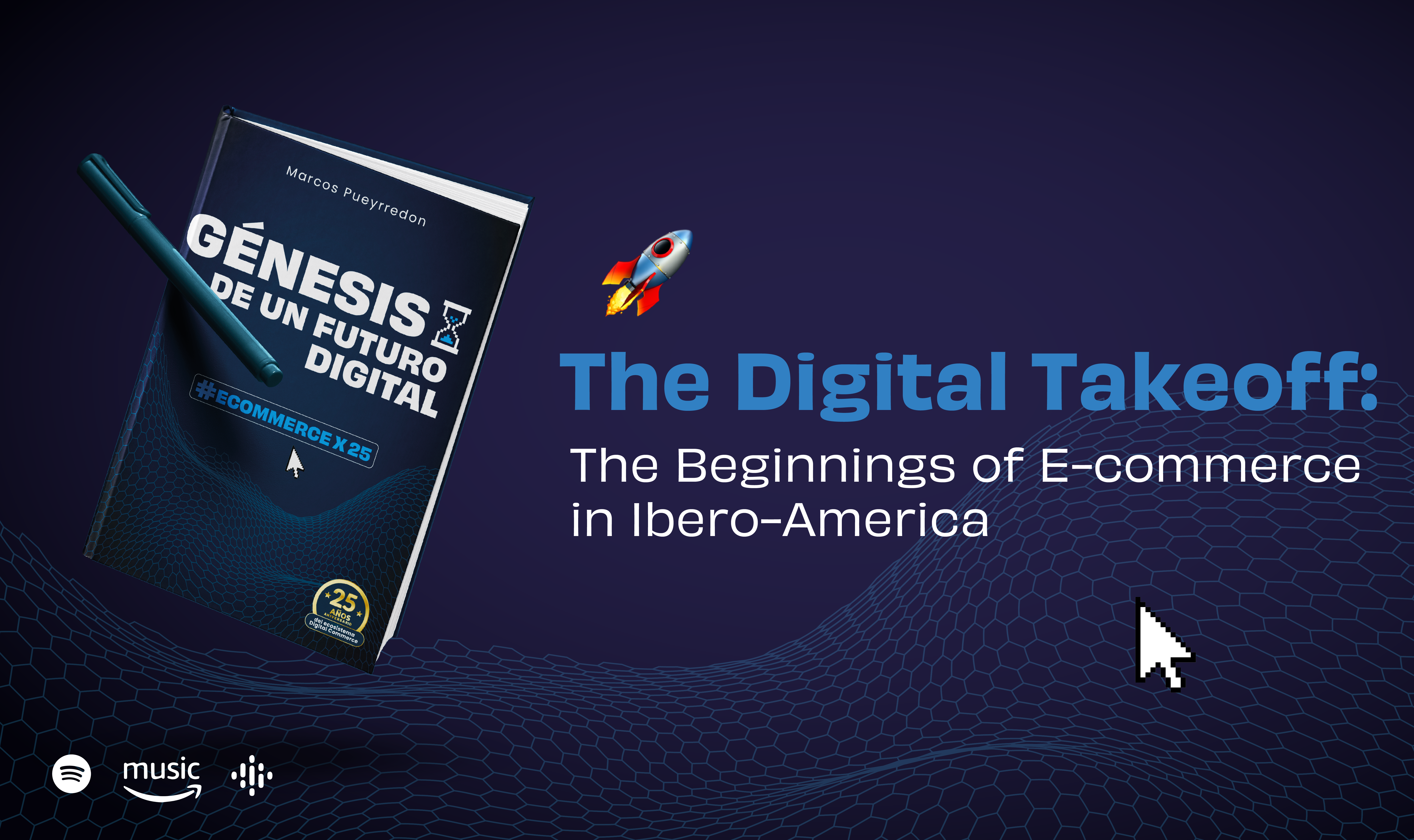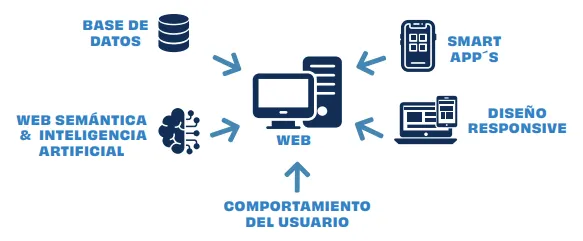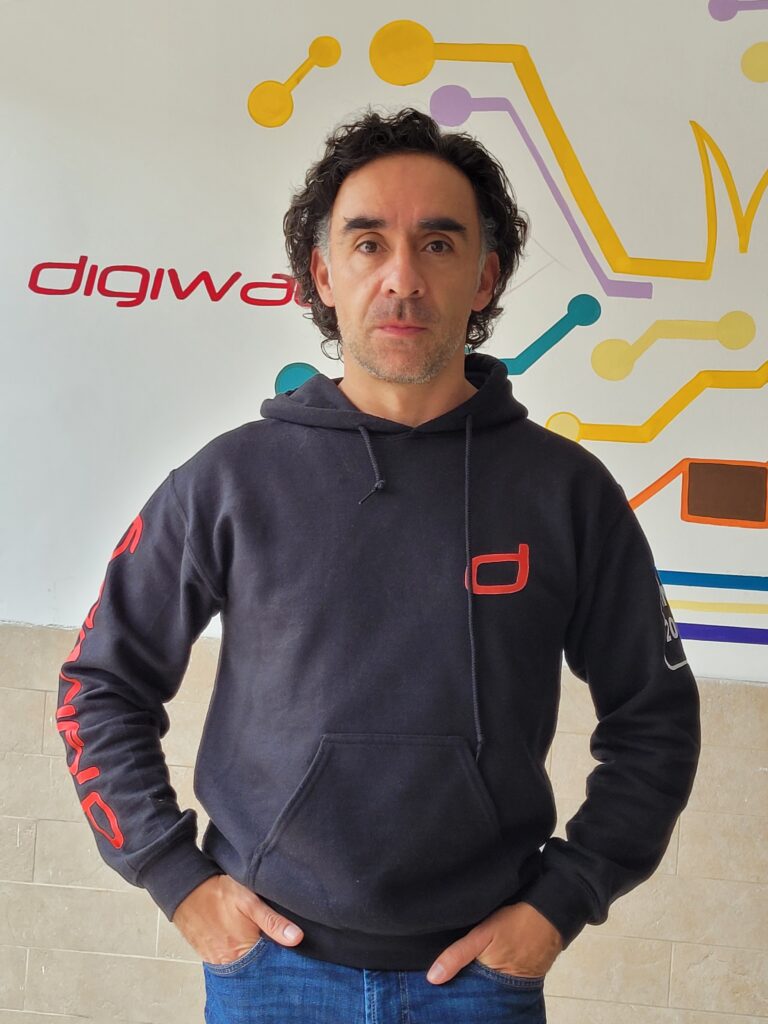

To kick off this book, the first of 25 fragments, I’d like to invite you to engage in a small exercise of imagination, harking back to a concept that emerged during the height of the Covid-19 pandemic: the eTsunami.
Let’s envision the digital ecosystem as a vast ocean, where the underwater currents are the invisible forces shaping its landscape. Much like tectonic plates shifting beneath the Earth’s surface, events and advancements in technology have generated seismic changes in the digital landscape.
In the early days of e-commerce, we could liken this moment to the emergence of a new underwater current, an initial force that was brewing in the depths of the digital ocean. This inaugural milestone, though seemingly insignificant, laid the foundation for what was to come—the beginnings of e-commerce in Ibero-America.
Just like underground aquifers, this initial force gained momentum, gradually moving toward the surface. As this underwater current rose, it gave birth to online commerce, a phenomenon that could be compared to the waves forming on the surface of the ocean.
These waves represent the growing visibility and accessibility of digital commerce, bringing with them a noticeable shift in how people interact with the virtual world. Over time, these waves grew into swells, symbolizing the consolidation of digital commerce as an industry in its own right.
This is where the clashes between the underwater currents become more evident, sparking revolutions in the digital landscape. It’s similar to when two tectonic plates collide, giving rise to earthquakes that alter the surrounding terrain.
This is the moment when the digital ecosystem undergoes a radical transformation, an eTsunami that reconfigures the way business is conducted and online interactions take place. However, despite the apparent destruction caused by these events, the digital ocean doesn’t disappear entirely.
Instead, it reinvents itself, adapting to the new landscapes that emerge after the chaos. Similarly, after each digital revolution, the ecosystem reshapes itself, yet it remains part of the same vast ocean of possibilities.
Just as this living book breaks down the milestones of the digital ecosystem, we could liken this methodology to exploring the marine sediments that reveal the ocean’s hidden history. By analyzing the key moments and experiences shared by those who were present from the beginning, the underlying narrative that has shaped Ibero-America’s digital ecosystem is revealed. It’s like unearthing fossils from the past to better understand the present and anticipate the future of the ever-evolving digital landscape.
In the following graphic, those who wish can explore each of these key moments, which we will reconstruct together from now on, further reinforcing the concept of a living book:
While we could discuss the origins of e-commerce without delving into any other aspect, it is worth refreshing the very roots of physical commerce. To do this, there’s nothing better than bringing into this living book the insights of Dimas Gimeno Álvarez, Former President of El Corte Inglés, and current founder and president of WOW Concept, who offers us a fascinating perspective on the birth and evolution of commerce over time.
He highlights how the retail sector began with small businesses in local communities and around urban centers. As he notes, “the original form of commerce, the first format that adds dimension, is the department store.” These stores marked the beginning of modern retail and date back to the 19th century, with iconic examples like Le Bon Marché in France or Selfridges in the United Kingdom, which consolidated various brands and shops under one roof, simplifying the shopping experience for consumers.
According to the expert (2024), this concept pioneered the transformation of the retail landscape, giving rise to iconic establishments such as Palacio de Hierro in Mexico, Falabella in Chile, Almacenes De Prati in Ecuador, and El Corte Inglés in Spain:
This statement underscores the importance of department stores as catalysts for change in retail. However, as he mentions, this model evolved over time to adapt to the changing needs of the middle classes and diversify even further.
The story shared by Dimas Gimeno Álvarez illustrates how the early steps of e-commerce can be traced back to concepts rooted in the history of physical commerce. It serves as a reminder that innovation often emerges from the reinvention of old ideas in new and emerging contexts.
That said, situating ourselves in the 20th century, it can be said that e-commerce first took root with catalog sales, which means it has existed for more than a hundred years, if we consider this fact.
It is worth exploring this origin, even if only superficially, to better understand what triggered what we now know as e-commerce.
Catalog sales emerged when Aaron Montgomery Ward, a traveling merchant supplying stores across the United States, devised a direct sales system from his point of sale in Chicago. His catalog, which started with 163 products, quickly grew and became a book of over 240 pages with thousands of different products within a decade.
The definitive push for this form of selling came in 1913 with the parcel post service, which allowed packages weighing up to 50 pounds to be delivered directly to homes. Throughout the 20th century, catalog sales became popular in the United States, Canada, and the United Kingdom, becoming the preferred method for millions of people who could not or did not want to go to physical stores. Although it competed with telemarketing for a time, the rise of e-commerce soon displaced the model, or rather, modernized it.
The subsequent arrival of the telephone and credit cards boosted e-commerce, providing convenience for both shoppers and brands.
In the 1960s, Electronic Data Interchange (EDI) marked another milestone by allowing companies to transmit financial information electronically, facilitating purchases, billing, and transactions.
Let’s not overlook that during the 1980s, teleshopping refined the catalog sales model by using television to showcase products and offering the possibility of purchasing by calling a phone number. This expanded accessibility and authenticity in product visualization for consumers. This is no small detail if we refer, some four decades later, to the Live Shopping model, which, among other aspects, replicates the old teleshopping format.
However, the true revolution came with the Internet. The creation of the World Wide Web in the 1990s democratized access to brands and products, giving rise to exclusive e-commerce portals like Amazon and eBay, which remain relevant today, with the former being one of the most important marketplaces in the world.
Additionally, in 1994, the G7/G8 countries launched the Global Marketplace for SMEs initiative, promoting the use of e-commerce by companies worldwide, marking a significant push towards the globalization of e-commerce.
Therefore, this journey through the origins allows us to understand that while catalog sales are recognized as the first milestone that marks the beginning of the e-commerce era in the world, its adoption and expansion on a regional scale required a combination of technological development, connectivity, and a deep maturation of business thinking.
These characteristics are, in fact, what allowed e-commerce to not only be a phenomenon but also a model that, over the years and through the events that occurred, demonstrated its solidity as an industry and its maturity as an ecosystem.
But this has not been the only milestone marked in the historical timeline. The Covid-19 pandemic, declared in 2020, is one of the latest turning points to which the digital takeoff of brands and retailers is attributed. However, when the pandemic was declared and forced businesses to deepen their digital transformation, both globally and in the region, the industry already existed and had a squadron of visionaries mapping the first routes to a digital future in the region.
For over a decade, these pioneers traversed Ibero-American territories, warning that the digital model was much more than a trend; it was the foundation upon which the economies of the future would be built.
As we see, the reality speaks of a longer journey, a historical cut that represents a quarter of a century from the origins of e-commerce in Ibero-America and its evolution into what we now recognize as the digital ecosystem.
In this book, we will delve into the details of that journey towards digital takeoff, exploring beyond the milestones mentioned here as significant and that marked the timeline of this phenomenon, from the first hesitant steps to the consolidation of a digital ecosystem.
Through the analysis of key moments, accompanied by the voices of the interviewed c-levels sharing experiences and anecdotes, we will shed light on the origins to better understand the current landscape of the digital ecosystem in the region and honor the legacy of those who paved the way for the digitalization of Ibero-American economies.
To fully understand the evolution of e-commerce, it’s essential to explore the various momentums that have redefined and shaped the current digital ecosystem. I chose this concept from the world of physics because it refers to the force or impetus by which a process advances in a specific direction. With this in mind, the momentums I will outline below have driven significant changes in the ecosystem, such as the development of new payment technologies, the expansion of mobile connectivity, and the mass adoption of smart devices.
To define these momentums, I interviewed over 150 c-level executives who not only shared their perspectives but also, as archaeologists of an industry that is now an ecosystem, helped me redefine many concepts learned through experience.
Thanks to in-depth fieldwork, analysis, and research, we will observe several milestones they have identified as momentums due to their impact on the industry’s formation and the transformations that have shaped it.
The global health crisis triggered drastic changes in how companies operate and how people interact digitally. The need for social distancing accelerated the adoption of digital technologies across all areas, from e-commerce to remote work, creating a fundamental shift in market dynamics.
Despite being one of the most voted milestones by c-levels in the region, it is important to note that for this event to become a momentum for the industry, many other situations had to converge, resulting in a timely response from retailers and brands during a special context. Therefore, a reflection can be opened on this:
Is it really a turning point or just a circumstance?
If it is a circumstance, what other momentums then contributed to making this circumstance so significant for the industry, society, and the economy?
We will leave this point open for analysis throughout the book, but by the end, you may reach this same reflection yourself.
The arrival and evolution of mobile devices, particularly with the launch of the first-generation iPhone, transformed the way people access information and conduct transactions. This evolution opened new opportunities for the development of mobile applications and e-commerce. For one of the historical figures in our ecosystem, Damian Voltes, SVP Corporate Development at Aleph Holding Director and Patagonia Ventures, this represents the second wave, or one of the three most representative momentums in the history of e-commerce in the region.
However, it is also important to note that mobile devices were not initially applied to the utility they serve today. Initially, they only allowed person-to-person communication, and it was not until they integrated Internet connectivity that they became a powerful tool for interaction and commerce at our fingertips. It is worth noting that from the appearance of the iPhone until the mobile boom, about ten years passed, considering that its use only became widespread in 2015, and the supply was ready a few years later, in 2018, when large volumes of traffic began to be observed.
Does this relativize this point as a key momentum in history, as the pandemic is questioned? In this case, and unlike the pandemic event, the arrival of mobile communications and the technological development of these devices are not mere circumstances and have had a complete impact on the evolution of e-commerce and its formation as an industry. We can even say that the development of telecommunications has put purchasing decisions in the hands of individuals.
Despite this, the time and growth of this technological device have not been sudden and were established in society before it was seen as a device that enables quick and convenient access for consumers. At this point, it is necessary to clarify that the presence of these devices required a volume of consumers first and a consumption habit later for the trend to begin to appear as an indicator.
On this subject, Guillermo Varela, CEO of Mr. Gen and current vice president of the Digital Economy Chamber of Uruguay, provides another perspective regarding the arrival of the iPhone in 2007, saying that it forced those we now call pioneers and visionaries in the region to “learn to program mobiles when there were no mobiles,” thus marking the habit among them to quickly adopt and adapt technological advances to the reality of commerce, which in the case of Ibero-America, still had much to explore.
He also explains that, although the iPhone presented such a challenge, the arrival of Palm devices already represented a significant challenge in 1998, but it could not be fully experienced due to limitations imposed by the U.S. government. Nonetheless, this did not limit him from founding Hands Soft, his most emblematic company, which responded to what this c-level already saw on the horizon: the possibility that anyone could have a device with software at their fingertips.
We will delve deeper into this point in the book from the Genesis of a Digital Future collection, where we explore the arrival of mobile commerce.
The arrival of local e-commerce platforms, such as Mercado Libre, democratized access to the digital market for sellers and buyers in the region. These platforms facilitated the model and promoted the inclusion of small and medium-sized businesses in the digital realm.
In the following momentums of this collection, we will see how the marketplace model has evolved and, more decisively, what the behavior of marketplaces and super apps was during the pandemic.
Twelve percent of respondents marked the arrival of electronic payments and the evolution of payment methods as a key momentum in the history of e-commerce in the region.
The advancement in electronic payment systems simplified online transactions and boosted the growth of e-commerce in the region. The evolution of payment methods was a significant contribution to the digitalization of the economy and improved the user experience in the purchasing process.
These highlighted momentums reflect the evolution and challenges of the Ibero-American digital ecosystem, highlighting the importance of adapting to new technologies and trends to drive economic growth and innovation in the region.
However, as previously mentioned, these were not the only milestones chosen by those who participated in the fieldwork, surveys, and interviews. Although the momentums mentioned above received more attention from the experts, other aspects have also significantly influenced the evolution of e-commerce in Ibero-America, such as mass convenience events and the evolution of the Web from 1.0 to 3.0.
But before delving into these two aspects, I want to pause on the point of view given to me by Alberto “Banano” Pardo regarding what he considers to be the three key momentums of digital commerce.
The first, as we have been discussing, is the Internet boom and the emergence of the first e-commerce companies (late 1990s), marked by the arrival of the Internet in Latin America and the emergence of pioneering e-commerce companies, such as MercadoLibre, Despegar, and Submarino.
These companies were founded during a period of optimism during the dot-com bubble, receiving significant investment that allowed them to grow and expand rapidly.
The second momentum, according to Banano, is the end of the “dark ages” and the resurrection of e-commerce (2006-2007). After a period of depression and skepticism towards the Internet in the early 2000s, e-commerce began to re-emerge. There was an increase in trust towards online shopping, especially in sectors such as tourism and retail, with companies like Lan, Frávega, Supermercados Wong, and Éxito leading the way in the region.
And finally, the third momentum is the influence of social networks on e-commerce (around 2010), with the proliferation of platforms that provided a new communication channel for e-commerce companies. This allowed companies to reach a wider audience more effectively and at a lower cost, democratizing access to e-commerce and generating greater awareness of online shopping among consumers.
Returning to the introduction, when I interviewed another historical figure in our ecosystem, Germán Quiroga, founder of Americanas.com and current board member of numerous retailers such as Centauro, Cobasi, and Falabella, among other companies, his account provided a very interesting allegory that aligns with the concept of an eTsunami: Quiroga compares the layers of the digital ecosystem to underground layers of water, suggesting that each layer represents a different opportunity for businesses.
These layers can be understood as moments of evolution or development in the digital landscape, where companies can dive in to find new growth opportunities. Referring to the eTsunami, he emphasized how the pandemic acted as a catalyst for massive acceleration in the digital realm, creating an unprecedented wave of transformation.
This “wave” drove the exponential growth of digital commerce, generating significant changes in the way companies interact with customers, adopting more digital and omnichannel strategies to meet the demands of today’s market.
This is how customers, as he described, triggered a succession of significant digital transformations, each larger than the previous, that are fundamentally changing the way businesses operate and interact with customers.
“The eTsunami is like when you go to the beach and see a giant wave and say, ‘Wow, look at that wave,’ and then a bigger one comes, and another bigger one. So, what are we living through? We are living through an era of eTsunamis. One comes, another comes, and another comes.” — Germán Quiroga.Starting in 2012, a phase of collaborative e-commerce emerged, marked by the creation of events aimed at promoting online sales, in some cases, while in others, the goal was to revitalize the country’s economy.
These initiatives are undoubtedly early manifestations of the industry’s great potential. However, their beginnings were strongly influenced by the results observed from events like Cyber Monday and Black Friday held in the United States. It is telling that the first such events in the region took place during the same time frame, adding further complexity to the experience.
These events have gained popularity in the region and have stimulated the growth of e-commerce by offering attractive discounts and special promotions. They have contributed to educating consumers about the benefits of online shopping and have provided a significant boost to sales in the sector.
During an interview with Alberto “Banano” Pardo, co-founder of Deremate.com and CEO & Founder of Adsmovil, and one of the pioneers in this field, we reminisced about those early steps that laid the foundation for what we now know as a thriving digital ecosystem.
“It all started with a simple invitation to breakfast,” Alberto tells me as we travel back in time to those days in Buenos Aires, around 2007. “I received a message on my BlackBerry from Juan Pablo Bruzzo, one of the co-founders of Dineromail.com, about an event organized by the Argentine Chamber of Electronic Commerce (CACE), and that message changed the course of my day and my life.”
I remember that meeting in a dimly lit office, where there were only about a dozen of us. It was at that moment that, with his characteristic energy, the idea arose: “Why don’t you start the Chamber of Electronic Commerce in Colombia?”
I enthusiastically agreed to the proposal, and soon we found ourselves in his office, debating strategies and envisioning a future of collaboration throughout Latin America. Thus, the first Latam E-Commerce Conference was born in Argentina, followed by events in Mexico, Chile, and Colombia.
However, it was during the eCommerce LATAM at the World Trade Center in Mexico City that we realized the need for a more scalable approach with regional impact and continuity over time, I recall as Banano recounts the evolution of our efforts.
The idea of E-Commerce Day—or as it’s known throughout the region, eCommerce Day—emerged as a practical solution, a national event that could easily cross borders. Over time, eCommerce Day has become the most important e-commerce and online business event in the region, a tour that has been held without interruption for 18 years, with more than 170 editions in 20 countries. Today, it is an example of consistency, perseverance, and collaborative work within the entire ecosystem.
Over the years, initiatives like those of the Argentine Chamber of Electronic Commerce and their counterparts in 22 other countries laid the groundwork for sustainable growth, with the support of a second-level institution like the Latin American Institute of Electronic Commerce or eCommerce Institute, which, through eCommerce Day, began to promote initiatives to foster the development of supply, generate a positive shopping experience, and increase consumer confidence in digital channels.
Since then, each country has celebrated its own mass convenience events, and from their origins, the local chapters of the eCommerce Institute in each country have collaborated to define and share best practices regarding the development of these events.
Here are some examples of mass convenience events held in various countries across the region:
These events have played a crucial role in shaping the digital ecosystem by fostering a culture of online shopping and providing opportunities for growth and innovation in the e-commerce sector across the region.
These are just a few examples of mass convenience events held in the region, but many other countries also have their own initiatives to boost e-commerce and offer consumers attractive shopping opportunities.
Another significant momentum highlighted by the surveyed experts was the popularization of Big Data, driven by the consolidation of the sector with service providers enabling the utilization of large volumes of data.
This development has allowed companies to better understand consumer behavior, personalize the shopping experience, and optimize their marketing strategies. The effective use of data has been key to enhancing the relevance of offers and increasing customer loyalty in e-commerce.
The emergence of the first user interaction platforms on the Internet, known as social media, is another significant momentum in the evolution of e-commerce and its digital takeoff.
Social media has become a vital channel for e-commerce, facilitating the promotion of products and services, as well as direct interaction with customers. It’s important to note how social media integrated into the industry long before they offered transactional options within their platforms.
Damian Voltes mentions that after the dot-com explosion, with the proliferation of mobile technology and greater connectivity, social platforms found a space for direct connection with users. Platforms like MySpace, Taringa, and Fotologs, among others, emerged, capturing people’s interest and turning them into users, creating a space that pivots between content consumption and self-production. The subsequent integration of purchasing options on platforms like Facebook, Instagram, and much later TikTok, ultimately created new opportunities to reach specific audiences and increase online sales, as well as giving users the opportunity to start their own businesses and experience entrepreneurship.
A few years later, he and his partner were ready to deploy everything they already knew they could do.
The implementation of technologies such as artificial intelligence and machine learning has allowed for the automation of processes, improvement in product recommendation personalization, and optimization of logistics in e-commerce.
These tools have contributed to increasing operational efficiency and enhancing the user experience on online sales platforms. For these more than valid reasons, they represent a milestone in the most current part of the historical timeline, closely tied to the digital takeoff of the sector.
In addition to major marketplaces like Mercado Libre, the emergence of specialized local platforms expanded the range of online products and services, offering more diverse options to consumers and additional opportunities for sellers.
These factors have also played a crucial role in the evolution of Ibero-American e-commerce by providing tools, platforms, and strategies that have driven growth and innovation in the sector. Their continued relevance and development are essential to further advancing the expansion and consolidation of e-commerce in the region.
The evolution of the web has been a continuous process marked by significant changes in how people interact with information and online applications. Over the decades, we have witnessed the emergence of different phases of the web, each with its own characteristics and technological advancements. From its initial conception to the present day, it is undoubtedly a fascinating journey that reflects not only technological progress but also how we have transformed our way of living and working online.

Web 1.0, which emerged in 1990, was characterized by the presence of static websites that offered information in a one-way manner. In this initial phase, interactivity was practically nonexistent, and users played a passive role, limited to browsing and reading content.
During this time, in Argentina, the portal GauchoNet was born in 1994, created by a young innovator named Gonzalo Arzuaga, who, according to the media of the time, made the first multimillion-dollar internet sale in the region during the 1990s.

In an interview with Damian Voltes, we realized the emergence of figures like these who marked what he considers the first wave of this quarter-century: “There are three major waves, from ’95 when the internet began to 2024, which is just starting. Each has its own bubble and peaks. You have to know when to get in and when to get out. These are windows that open and close, especially in technology where cycles are getting faster and faster,” he said, referring to Gonzalo Arzuaga’s timely decision to sell GauchoNet, distinguishing himself from figures like Marcos Galperin—founder and CEO of Mercado Libre—who remained with his business for over 20 years.
“During this wave, first came the internet providers to offer connectivity, infrastructure, etc., but then came the portals, which were like gateways to the internet. That’s where we find AOL, Terra, Yahoo!, among others, all functioning as the entry points to the internet, and later each portal began to define itself by verticals, such as sports, finance, etc.,” he commented. With this definition, Voltes confirmed that even though this was a time when websites offered limited usability, the businesses behind this dam continued to inflate the bubble until it finally burst.
For his part, Guillermo Varela said about this period that, for him, it represented the beginning of his pivotal years:
His comment is noteworthy because the giant faced by the visionaries and pioneers of the then-emerging e-commerce was not only the lack of volume but also the distrust and ignorance that Varela mentions. Some platforms of that time included:
At this point, it’s interesting to consider the perspective of Laureano Turienzo, founder of the Spanish Retail Association (AER) and current CEO of Retail New Trends, on the development of e-commerce and the fundamental role that trust plays in its evolution.
Turienzo highlights an initial phase that lasted approximately 10 to 15 years, characterized by the construction of credibility in the digital medium. As Turienzo mentions: “The first big step was really that, to reach the global middle class: to be able to trust what was behind the computer screen.”
This statement underscores the importance of trust in e-commerce, a crucial element for consumers to adopt and use this platform. It emphasizes how the shift from an analog to a digital interface involves not only a technological transformation but also a human one. He argues that, ultimately, “e-commerce is about people buying from other people.”
“The big step forward for e-commerce is when you massively gain a concept as human as trust,” Turienzo emphasized. Undoubtedly, trust is a fundamental pillar that underpins the success of e-commerce. As more people found that their online purchases were problem-free, trust in technology and online sellers began to increase significantly.
This evokes a reflection: “Behind the screen and the technology, there are human beings making purchasing decisions and selling products,” says the expert. This human connection is essential to understanding the success and evolution of e-commerce over time.
Web 2.0 represents the second phase in the evolution of the web, spanning from 2004 to the present. This stage marked the introduction of interactivity and collaboration on the web. Social media platforms and blogs emerged, giving users the ability not only to consume content but also to create it.

For Damian Voltes, this stage was not only dominated by the evolution of websites but also saw the strong presence of mobile development and maturation. At that time, Nokia and Motorola competed for the market until the arrival of Blackberry, but with the introduction of the iPhone, the rules of the game changed. According to Voltes, this was the arrival of “a device that was born dumb but became smart because it was 100% connected.”
It’s also worth noting that the shift towards Web 2.0 largely emerged as a response to the dot-com crisis. This phase introduced three fundamental principles that enabled user interaction with web platforms: the conception of the web as a platform itself, the concept of collective intelligence, and the implementation of a participatory architecture.
Examples of Web 2.0 websites and services include:

Web 3.0 represents the next phase in the evolution of the web, characterized by artificial intelligence, semantics, and personalization. In this stage, the web is expected to be more intelligent and capable of understanding user context and preferences, offering more personalized and relevant experiences by focusing on data integration and the interconnection of information.
Examples of technologies and applications associated with Web 3.0 include:
In addition to the evolution of the web stages, other milestones have influenced its development, and here we highlight two:
In the late 1990s, there was excessive speculation around internet companies. “Get big fast” was the mantra that organizations recited during that time, reflecting the corporate strategy behind their rapid growth. The following Nasdaq chart illustrates this stage:
Many of these so-called dot-com companies collapsed, even as a series of technological innovations and viable business models began to emerge.
This phenomenon was driven by technological progress and economic globalization, which was also associated with the rise of Nasdaq, the formidable rival to the traditional Wall Street stock exchange.
The bursting of the dot-com bubble was a significant event that marked a turning point in the digital economy, highlighting the importance of sustainable business models and the need for proper regulations to prevent excessive speculation. Experts from the first wave, such as Sergio Grimbaum, former co-founder of Deremate.com and CEO of Think Thanks, identify this milestone as the first major momentum in the history of e-commerce in the region.
“The bubble is the great momentum; we were all inside a tunnel, and suddenly it changed, the bubble burst, and everything collapsed. We didn’t really know what we were chasing after all; they pushed us toward user acquisitions, client transactions—everything but actual business. After the bubble, growth came, and it didn’t matter if there was revenue or not. It was a milestone because it forced us to wake up, especially in Argentina, where we suffered through it right after a crisis” —Sergio Grinbaum.
For e-commerce to exist, it was necessary to have a significant volume of traffic and merchants venturing into the online world. However, it wasn’t until the early 2000s that the increase in broadband availability and speed enabled a richer, more multimedia browsing experience, which ultimately drove the development of more advanced online services and widespread adoption of the internet in households.
The evolution of the web is a dynamic process that continues to change, with new technologies and emerging trends constantly shaping how we interact with information and each other online.
It’s important to note that in the region, less than half of the population has access to fixed broadband, and only 10% have high-quality fiber at home. Poor and uneven coverage, along with the high costs of data and devices, continue to hinder digital access.
Implementing effective policies and measures to improve digital accessibility is crucial to ensuring that all sectors of society can benefit from the opportunities offered by the digital economy.
Exploring these 25 years, collecting anecdotes, and tracing a timeline that allows us to visualize the journey taken by visionaries and pioneers, it is noteworthy that the highlighted momentums marked as true milestones are:
First Momentum: The Dot-Com Bubble Burst
Undoubtedly, this turning point changed how platforms were perceived, transforming them from mere connection spaces into powerful commercial engines. The bubble’s burst led to a period of darkness where even mentioning online platforms and their benefits was taboo. Reversing this mindset required rethinking how to market online. Many years later, another milestone, the pandemic, would provide a foundation for usability, but until that external condition emerged, society, technology, the economy, and even the way of selling evolved, learning to implement the rules of the game that would later need to be broken.
Second Momentum: The Introduction of Smartphones
Although an entire book in this collection is dedicated to this topic, it’s important to acknowledge that each mobile device that came to market offered something different to the user. We must also recognize the pioneers who knew how to incorporate these devices into the online sales proposition.
Saying that smartphones are here to stay would ignore the evolutionary potential of these devices, which have not yet reached their innovation peak. Thanks to breaking the mold with different types of software and operating systems, smartphones will eventually transcend screen-based interactions to welcome users into a physical world, but it will take a bit more time before we discuss that.
Third Momentum: Omnichannel and Data Utilization
The mindset shift that retailers and brands have made as a result of the experiences brought on by the pandemic has allowed them to adapt to the changes in consumer habits. This is a major turning point and maturation of the industry, which now transitions into an ecosystem based on a unified, conversational, and collaborative commerce model, capable of responding personally to needs through the appropriate and assertive use of data, regardless of the point of contact or sales channel, whether digital or offline, throughout the consumer’s journey to the product or service offer.
This leads to a reflection on a fourth momentum, not explicitly mentioned here but recognized by the interviewed experts as such: the fourth wave, driven by exponential technologies, with artificial intelligence and machine learning at the forefront, combined with blockchain, augmented reality, and more, which we will continue to explore in depth in the upcoming momentums of this collection.
Today, these technologies are often met with skepticism and even rejection, but we will soon see how their integration into the digital ecosystem will be essential for streamlining processes, positively resolving the supply chain up to the final consumer, and freeing up teams to handle the most complex processes in the simplest way.
It seems that many loose ends remain, and I invite you to read the reflections of Commerce Society AI below and interact actively with it.
Stay tuned for the next publications because if we have traced a sort of historical line so far, with crucial milestones and momentums for the digital ecosystem, we will soon delve into some anecdotes—funny, overwhelming, and even filled with very technical concepts—but experiences that help reconstruct our journey through 25 years of this ecosystem with real events.
The content you’ve just read is alive, meaning that the information will be continuously updated. If you believe you have any data, testimonials, cases, anecdotes, studies, or research that could enrich the shared knowledge on the genesis of the digital ecosystem to add to this or future books in this collection, you can complete the online form at genesisfuturo.digital.
Finally, I recommend subscribing to notifications to stay informed about updates or the release of upcoming books, and as many of you already know: we remain online.
Genesis of a Digital Future is not just a book; it is a living testament to the moments and contributions of the key pioneers who have shaped the digital ecosystem in Ibero-America. Through firsthand accounts and deep research, this project documents the 25 momentums that have marked the evolution of e-commerce from its inception to the present.
Each momentum is an invitation to navigate the ever-changing and evolving digital ocean, riding the waves and eTsunami that marked a before and after for the ecosystem, recognizing each step taken by the visionaries and pioneers who shaped the e-commerce industry, and discovering the latest technological innovations.
The living book offers a unique learning and discovery experience that provides a comprehensive perspective of the past, present, and future of the digital ecosystem in our region.
Explore the upcoming momentums that reveal the secrets, challenges, and triumphs behind the world of Digital Commerce in Ibero-America:
Based on in-depth documentary work and the contributions of more than 200 pioneers and experts of the digital ecosystem, this book interweaves multiple stories to offer a complete and collaborative vision of the history and development of digital commerce in Ibero-America.

Wilbur Mauricio Ordóñez Mariño es un destacado director de canales digitales con más de 20 años de experiencia en el ámbito de Ecommerce, Omnicanalidad y Marketplaces. Su misión se centra en crear e implementar estrategias digitales y comerciales que no solo generen valor y aumenten los ingresos, sino que también optimicen la eficiencia de los negocios online en sectores como medicamentos, electrodomésticos, moda y hogar en toda América Latina.
Actualmente, dirige la estrategia digital de Colsubsidio, una de las empresas más importantes de Colombia, focalizando sus esfuerzos en los segmentos institucional y comercial. Bajo su liderazgo, Colsubsidio ha consolidado su posición en el mercado de medicamentos online. Además, ha sido un pilar en la transformación omnicanal de la empresa, integrando exitosamente los canales de Ecommerce, App, Contact Center, Chat y Mundo Digital.
Es también un reconocido speaker y conferencista en temas de Ecommerce, Omnicanalidad y Transformación Digital, participando en eventos tanto nacionales como internacionales. Su pasión por la innovación y su compromiso con el aprendizaje continuo lo impulsan a compartir su conocimiento y experiencia con otros profesionales y organizaciones, enriqueciendo el ecosistema digital en la región.
Con una visión estratégica y un sólido entendimiento del entorno digital y comercial, Wilbur Ordóñez Mariño continúa liderando proyectos de alto impacto, contribuyendo al crecimiento y fortalecimiento de los canales digitales en Latinoamérica.

Vanesa Gambirazio es una profesional dedicada a la creación de soluciones de transformación digital con un alto impacto en negocios y proyectos. Su experiencia se centra en proyectos de e-commerce en países como Perú, Argentina, México y Colombia, donde trabaja en colaboración con las principales Cámaras de Comercio Electrónico de la región.
Asesora a empresas en el desarrollo eficaz de proyectos de comunicación, marketing, social media y plataformas digitales, con un enfoque especial en la implementación de tiendas online. Además, imparte cursos y talleres sobre UX, e-commerce y accesibilidad.
Es cofundadora de Pulip Flex Market Sale, una plataforma para la creación y gestión de eventos de descuentos, donde ejerce como Founder & Directora de ID4YOU.
Es miembro de la Comisión Directiva de CACE, y anteriormente fue Vicedirectora de la Comisión de Marketing de la misma organización. Actualmente, también forma parte del Consejo Ejecutivo de Semillero Digital.

Sergio Grinbaum es un visionario ejecutivo con una destacada trayectoria internacional en el liderazgo de iniciativas de transformación digital y marketing de crecimiento. Desde enero de 2007, es el CEO de Think Thanks, una firma consultora de estrategia digital con presencia en México, Ecuador, Panamá, Centroamérica, Colombia, Argentina, Chile, Perú, Uruguay, EE.UU., y España. Bajo su dirección, Think Thanks se ha consolidado como un líder en el desarrollo e implementación de estrategias de transformación digital, especializándose en SEO, medios digitales SEM, analítica, comunicación, comercio electrónico, lealtad y recurrencia de clientes, así como sostenibilidad.
Lidera el equipo de Metaverso en Think Thanks, enfocándose en tecnologías de aceleración para el sector retail y transaccional. Su expertise en el campo digital está también respaldado por asociaciones estratégicas como Google Premier Partner y Meta Partner, y su experiencia en publicidad programática DV 360.
Antes de su actual posición en Think Thanks, co-fundó y fue Director Regional de Operaciones de Deremate.com desde 1999 hasta 2006, donde jugó un papel crucial en el establecimiento de la plataforma de comercio electrónico como una de las más prominentes en Latinoamérica.
Además en 2004, co-fundó Grupo COVEDISA, un emprendimiento dedicado a la consultoría y desarrollo de soluciones digitales para empresas. Adicionalmente, en 2001, Sergio co-fundó y trabajó como consultor en Baazee.com y Vatera.com, donde aplicó sus conocimientos y habilidades en la gestión y asesoramiento de startups enfocadas en el comercio electrónico.
La carrera de Sergio Grinbaum destaca por su profundo conocimiento en estrategia y ejecución digital, un enfoque firme en resultados medibles y sostenibles, y un compromiso con la innovación continua en el ámbito de las nuevas tecnologías y el marketing digital. Su liderazgo en Think Thanks y otras empresas ha impulsado la transformación digital de numerosos clientes, estableciendo a Sergio como un referente en la industria del marketing digital y la consultoría estratégica a nivel global.

Con más de dos décadas al mando de Snoop Consulting, Sergio Candelo ha fomentado la innovación y la transformación digital en diversos entornos empresariales.
En el Consejo Consultivo de CESSI, su rol sintetiza los conocimientos de la industria con una visión estratégica para seguir avanzando el sector del software en Argentina. Su trayectoria desde Presidente hasta asesor en CESSI refleja un compromiso con el crecimiento y la competitividad de la industria del software. Colaborando con las partes interesadas, ha cultivado un ecosistema colaborativo que prospera gracias al conocimiento compartido y al liderazgo progresivo.
Ha liderado Snoop Consulting desde su fundación, enfocándose en la innovación digital y la transformación tecnológica, consolidando la posición de la empresa en el mercado.
En su rol actual en PMI Buenos Aires, como vicepresidente en finanzas, supervisa la gestión financiera, asegurando la estabilidad y el crecimiento económico de la organización. Hasta el 2020, como presidente de PMI Buenos Aires, lideró la organización en la promoción de buenas prácticas en la gestión de proyectos, fortaleciendo la comunidad profesional de la gestión de proyectos en la región.
Sergio Candelo es reconocido por su liderazgo visionario, su capacidad para fomentar la innovación y su dedicación al crecimiento sostenible y competitivo del sector del software en Argentina.

Sebastián Mantica es un experimentado profesional en el ámbito del comercio electrónico y la gestión de negocios digitales, con una sólida trayectoria en la industria de la tecnología y el retail. Desde el 2015, se desempeña como Ecommerce & Digital Business Manager en Cetrogar S.A., donde ha sido clave en la transformación digital de la compañía, impulsando el crecimiento del canal online y optimizando la experiencia del cliente en el entorno digital.
Antes de su rol en Cetrogar, trabajó en Frávega SACIEI, donde desempeñó funciones cruciales en dos posiciones. Hasta 2015, fue Ecommerce Manager, liderando el desarrollo y expansión del comercio electrónico de la empresa, y previamente, fue Category Manager, gestionando categorías estratégicas y mejorando la rentabilidad de los productos en el mercado.
Su carrera comenzó en Carrefour, donde fue Brand Manager IT, gestionando la estrategia de marca para la categoría de tecnología, y en IBM, donde trabajó como Brand Manager, desempeñando un rol fundamental en el posicionamiento de la marca en el mercado.
Sebastián Mantica se destaca por su capacidad para liderar proyectos de transformación digital y comercio electrónico, combinando su profundo conocimiento del sector con una visión estratégica orientada a la innovación y al logro de resultados sobresalientes. Su experiencia en la gestión de marcas y categorías, junto con su habilidad para adaptarse a las tendencias del mercado, lo convierten en un referente en el ámbito del comercio digital y la tecnología.

Sara Carbajo Suárez posee un extenso conocimiento profesional en el ámbito del comercio electrónico. Su carrera comenzó en los primeros años impulsando el crecimiento de una start-up española especializada en ventas flash, que posteriormente fue adquirida por Amazon en 2011.
En una etapa posterior, se enfocó en el mercado de Oriente Medio, desempeñándose como Gerente de Cuentas Clave en el sector de la moda para un marketplace presente en siete países. En esta última etapa, ha centrado sus esfuerzos en la comercialización de una plataforma de eCommerce muy enfocada en la conversión.
Desde 2021, se desempeña como Ecommerce Manager en IQVIA Spain, donde ha liderado exitosamente diversas estrategias de comercio digital.
Anteriormente, trabajó como Business Developer Commerce Solutions en Increnta, donde desarrolló soluciones innovadoras para el comercio digital, optimizando la experiencia del usuario y aumentando la conversión.
En vdSHOP, ocupó dos roles clave: primero como Head of Brands y luego como Manager of Sourcing & Brands. En estos puestos, supervisó la gestión de marcas y el abastecimiento, asegurando el alineamiento estratégico con los objetivos comerciales de la empresa.
Antes de su tiempo en vdSHOP, fue parte de VTEX, donde trabajó en Corporate Sales para España y Portugal. Su rol implicaba la gestión de ventas corporativas, fortaleciendo la presencia de la empresa en el mercado ibérico y desarrollando relaciones comerciales clave.
Con una trayectoria que abarca diversos roles estratégicos en el comercio electrónico, Sara Carbajo Suárez ha demostrado una capacidad excepcional para liderar y ejecutar proyectos que impulsan el crecimiento y la innovación en cada organización en la que ha trabajado.

Salustio Prieto es un destacado profesional con una sólida formación académica. Su trayectoria abarca una amplia experiencia en ventas, desarrollo de negocios, planificación estratégica, marketing y gestión general, con un enfoque particular en servicios logísticos, aerolíneas de carga, venta directa (MLM), mensajería y bienes de consumo.
Especialista en servicios logísticos, marketing B2B, desarrollo de negocios e innovación, inició su carrera en el ámbito del transporte marítimo y aéreo de carga, donde comenzó en el área de ventas y ascendió a posiciones directivas como Director de Ventas y Marketing, y Director General en empresas líderes del mercado chileno. Entre estas destacan Lan Cargo Airlines, LanCourier, Oriflame, TW Logistics (3PL), Undurraga Wines y CorreosChile.
Es fundador y primer presidente de la Asociación Logística de Chile (ALOG), un hito que marca su compromiso con el desarrollo del sector logístico en el país. En 2010, fue designado Director de Marketing, Desarrollo de Negocios e Innovación en CorreosChile, y en 2012, volvió a formar parte del directorio de ALOG. Además, ha sido miembro del comité de expertos en el ILCE (Instituto Latinoamericano de Comercio Electrónico).
Actualmente, enfrenta nuevos desafíos como CEO y Co-Fundador de Next4, una empresa de capital de riesgo, desarrollo de negocios y representaciones comerciales para América Latina, con un enfoque en e-Commerce, economía colaborativa y gestión de la cadena de suministro. También es Director Fundador de PickTac, CEO de Acceleron, Co-Fundador y Presidente del Consejo de PalletParking, y miembro del consejo de QMATCH-eCommerce Intelligence. Su liderazgo y visión innovadora continúan impulsando la evolución de estos sectores en América Latina.

Roby Cibrián es un apasionado de la inteligencia de negocios en la web, y su empresa está 100% enfocada en generar la mejor solución para mejorar las tasas de conversión de clientes y automatizar los procesos de generación de contenido.
Es arquitecto, pero su amor por la tecnología, y principalmente por las computadoras, lo llevó a fundar Braindw, una empresa completamente dedicada al desarrollo de una plataforma que soluciona estos problemas.
Como emprendedor digital, fundó Cibrián Campoy Creativos (CCC) y produjo grandes aplicaciones multimedia para empresas como Impsat, Pfizer, Telefe, Banelco y Visa, entre otras.
En su faceta de emprendedor en Internet, fundó El Sitio (www.elsitio.com), uno de los portales líderes en América Latina y la única empresa de Internet con base en Latinoamérica que salió a bolsa en los mercados tecnológicos de EE.UU., NASDAQ, con el ticker LCTO.
Creó ESDC, El Sitio Digital Channel (hoy Mixplay.tv), el primer portal multimedia en Latinoamérica que incluía comunidades 3D y video digital.
Fundó CCD2 (Cibrián Campoy Digital), una empresa enfocada en servicios de alta tecnología para Internet. Los productos principales incluyen comercio electrónico, e-learning, sistemas de gestión de contenidos (CMS), videoportales para la web y aplicaciones de minería de datos.
Actualmente, su empresa, New Digital Way, ha desarrollado todas las habilidades para llevar a cabo la creación y desarrollo de una plataforma de inteligencia en línea en tiempo real, llamada Braindw.

Ricardo Garrido es un ejecutivo con amplia experiencia en la gestión empresarial, liderando startups, transformando estrategias en operaciones eficientes y rentables, construyendo y liderando equipos multidisciplinarios, trabajando en empresas globales, desarrollando alianzas estratégicas sólidas con empresas de clase mundial y llevando a cabo cambios complejos en el entorno empresarial.
Se desempeña como Director de Marketplace para Amazon en Brasil, donde es responsable de la estrategia y operación de la plataforma, asegurando su crecimiento y eficiencia en el mercado brasileño.
Antes de su rol actual, lideró el equipo de Alexa en Brasil, donde gestionó la introducción y expansión del asistente de voz de Amazon en el país, trabajando en estrecha colaboración con equipos globales para adaptar la tecnología al mercado local.
Además encabezó el equipo de Adquisición de Contenidos para Kindle en Brasil, incluyendo la negociación con editoriales y la plataforma Kindle Direct Publishing. Su liderazgo fue crucial para el crecimiento del catálogo de contenidos en la región.
En Tegma, fue Director General de la Unidad de Negocios de Logística Integrada, donde desarrolló operaciones de comercio electrónico para empresas como Nespresso y FNAC, consolidando a Treelog como una de las mayores empresas de logística en Brasil.
Desarrolló y lanzó iba (iba.com.br), la plataforma de comercio electrónico de Abril Media para la venta y distribución de contenido digital. Lideró la distribución de contenido digital de Abril mediante el desarrollo de alianzas estratégicas con empresas como Adobe, Google, Apple y Nova Pontocom. También lideró el proceso de adquisición y gestión de Xeriph, una startup brasileña pionera en el negocio de e-books en Brasil.
Ricardo Garrido es conocido por ser asertivo, flexible y ecléctico, destacando su habilidad para involucrar a diferentes personas en una visión común. Su capacidad de aprendizaje rápido y sus habilidades agudas para resolver problemas son también parte de sus fortalezas.

Ricardo Alonso es un profesional con más de 25 años de experiencia en la industria del retail y comercio electrónico. Emprendedor e innovador, posee una destacada trayectoria en la formulación de estrategias y gestión de procesos en tiendas por departamentos, operaciones de tiendas, centros comerciales, comercio electrónico y marketplaces. A lo largo de su carrera, ha gestionado con éxito la compleja dinámica del retail omnicanal, equilibrando sinergias y promoviendo un crecimiento agresivo. Su visión del e-business ha sido reconocida en el sector, siendo pionero en la adopción y desarrollo de innovaciones, y un líder impulsor de iniciativas regionales en el ecosistema digital de Latinoamérica.
Actualmente, es socio de The Blue Commerce Consulting & Partners, una consultora boutique especializada en retail, con operaciones en Europa y Latinoamérica. Aquí, contribuye con su vasta experiencia en la industria para ofrecer soluciones estratégicas a diversas empresas del sector.
Desde enero de 2023 es miembro del consejo de Freedom. Proporciona orientación estratégica y apoyo en la toma de decisiones clave, aprovechando su amplia experiencia en el comercio electrónico y el retail.
En su rol de consejero en la Cámara de Comercio de Santiago, colabora en la definición de políticas y estrategias para fortalecer el comercio en Santiago, aportando su conocimiento en innovación y transformación digital.
Además es fundador e inversor de Casaplanta Chile, donde aplica su enfoque emprendedor para impulsar el crecimiento y desarrollo de esta empresa en el sector de la horticultura y el diseño de interiores.
En su cargo de Vicepresidente Ejecutivo de Marketplace en Falabella Group, lideró la estrategia y operación de uno de los marketplaces más grandes de Latinoamérica, logrando significativos avances en la integración omnicanal y el crecimiento del comercio digital.
Ricardo Alonso se destaca por su compromiso con la excelencia y su capacidad para impulsar cambios significativos en las organizaciones con las que colabora, siempre enfocado en el crecimiento sostenible y la innovación continua.

Reynaldo Musso es un destacado manager con más de 15 años de experiencia en el desarrollo de soluciones digitales y la implementación de transformaciones ágiles. A lo largo de su carrera, ha sido responsable de liderar diversos equipos de producto, diseño y tecnología, logrando un crecimiento sostenido del negocio mediante la creación y operación de soluciones digitales innovadoras.
Su liderazgo en estos equipos multifuncionales ha resultado en el éxito de múltiples iniciativas, incluyendo el desarrollo de aplicaciones móviles para iPhone y Android en Latinoamérica, y el nuevo e-commerce de Abcdin.
Ha sido un actor clave en procesos de transformación digital en empresas de renombre como LATAM.com, Abcdin, Salcobrand y Preunic, donde ha impulsado cambios que han hecho a los equipos de trabajo más colaborativos y productivos. Su amplio conocimiento en diferentes industrias, incluyendo aerolíneas, retail, retail financiero y farmacias, le ha permitido adaptarse y liderar con eficacia en diversos contextos.
Reynaldo Musso ha demostrado ser un líder adaptable y eficaz, siempre orientado a mejorar la experiencia del cliente y a fomentar la innovación dentro de sus equipos. Su trayectoria refleja un compromiso constante con la excelencia y la transformación digital, posicionándose como un referente en la gestión de productos y proyectos tecnológicos.

Pierre-Claude Blaise cuenta con 20 años de experiencia en grandes empresas y start-ups, de los cuales ha dedicado 10 años a nivel C, guiando y promoviendo la transformación de organizaciones para prosperar y desarrollarse en el entorno digital.
Ha diseñado una visión del futuro para proyectar el cambio y hacerlo realidad mediante el desarrollo e implementación de una estrategia tanto offline como online.
Durante los últimos 5 años, ha liderado el crecimiento del comercio electrónico en México a través de diferentes iniciativas estratégicas clave, generando más de 12 millones de nuevos compradores y $2 millones USD en ventas.
Posee experiencia internacional con un enfoque local en Japón, Alemania, Francia y México, habiendo supervisado globalmente más de 35 países, liderando equipos multifuncionales de más de 30 personas y equipos directos de hasta 20 personas.
Pierre-Claude Blaise cree que la nueva era del negocio digital en la que hemos entrado requiere visión, iniciativa y mentalidad abierta, pero también velocidad y calidad en la ejecución.

Pedro Merino es un periodista licenciado en Ciencias de la Información, Socio Director y Co-fundador de Ecommerce News, el principal medio de comunicación de España y Latinoamérica especializado en información sobre comercio electrónico, marketing online y economía digital. Desde su fundación en 2012, Ecommerce News se ha consolidado como una referencia en el sector, alcanzando más de 130.000 usuarios únicos mensuales.
En su trayectoria, ha expandido su influencia en el ámbito de las nuevas tecnologías y la transformación digital. Desde 2017, ha co-fundado dos medios de comunicación adicionales: Big Data Magazine y Cyber Security News, ambos enfocados en áreas críticas como el Big Data y la ciberseguridad. En estos roles, ha dirigido la estrategia y el crecimiento de las publicaciones, convirtiéndolas en recursos indispensables para los profesionales del sector.
Además, es Co-fundador de eCommerceCoach, una plataforma dedicada a la formación y asesoramiento en comercio electrónico, y Socio Ejecutivo de Pomaikai Comunicación, donde aplica su expertise en comunicación y marketing digital para diversas empresas.
Pedro Merino se especializa en Internet, Redes Sociales, Marketing Online, Comercio Electrónico, Big Data, Ciberseguridad, Inteligencia Artificial, Fintech, Marketing y Transformación Digital. Su amplia experiencia y conocimientos en estos campos le han permitido liderar proyectos innovadores y convertirse en una figura influyente en el panorama digital.

Patricia Jebsen es una experimentada asesora y miembro de juntas directivas, con una sólida trayectoria en diversas áreas de negocio. Actualmente, desempeña varios roles de liderazgo en reconocidas empresas de América Latina.
Como Business Advisor en Seeds, contribuye con su vasta experiencia para guiar el crecimiento y la estrategia de negocio de la empresa, apoyando la toma de decisiones clave para el desarrollo sostenible.
Como Omnichannel Board Advisor en Coppel México y Omnichannel Board Advisor en Coppel Argentina, aporta su profundo conocimiento en estrategias omnicanal, ayudando a Coppel a fortalecer su presencia tanto en el mercado mexicano como en el argentino. Su enfoque está en mejorar la experiencia del cliente a través de la integración de canales digitales y físicos.
Además, es Board Member en Chatcenter desde septiembre de 2023. En este cargo, participa activamente en la toma de decisiones estratégicas para impulsar el crecimiento y la innovación en la empresa, que se especializa en soluciones de comunicación y atención al cliente.
También es Board Member en CUIDARLOS. Aquí contribuye con su experiencia para apoyar la misión de la organización, que se enfoca en brindar cuidados y servicios de salud a personas mayores y dependientes.
Patricia Jebsen es reconocida por su capacidad para liderar en entornos complejos, su enfoque estratégico en la omnicanalidad y su habilidad para impulsar la innovación y el crecimiento empresarial. Su rol como asesora y miembro de juntas directivas la posiciona como una figura clave en el desarrollo de estrategias empresariales exitosas en diversas industrias.

Pablo Altamira es un asesor experimentado con una sólida trayectoria en la industria del comercio electrónico. A lo largo de su carrera, ha demostrado ser un profesional altamente competente, especializado en ecommerce y emprendimiento.
Desde el 2019, ocupa el puesto de Country Manager en Producteca México, donde ha sido clave en el desarrollo y expansión de la empresa en el mercado mexicano. Anteriormente, desempeñó el mismo rol en Producteca Argentina, donde lideró con éxito las operaciones en el país, consolidando la posición de la empresa en el mercado local.
Además de su experiencia en gestión, ha sido coordinador del programa de eCommerce en Digital House, una destacada institución educativa enfocada en la tecnología y la innovación. En este rol, contribuyó a la formación de nuevos talentos en el campo del comercio electrónico.
También es un emprendedor, habiendo co-fundado dos empresas antes de unirse a Producteca. Fue co-fundador de EmprendING, una plataforma dedicada a fomentar el espíritu emprendedor. Anteriormente, en 2009, co-fundó Parsimotion, una empresa enfocada en soluciones tecnológicas para el comercio electrónico.
Con una combinación de experiencia en liderazgo, educación y emprendimiento, Pablo Altamira ha dejado una huella significativa en la industria del comercio electrónico en América Latina.

Nicolás Valenzuela es Gerente de Digital Commerce en Cencosud S.A., el mayor grupo de retail de Latinoamérica, donde lidera los negocios digitales de las marcas Jumbo, Easy, Disco, Blaisten, Vea y Retail Media. Desde que asumió este cargo en octubre de 2021, ha desarrollado la unidad digital con un enfoque en el crecimiento, la rentabilidad, la experiencia del cliente y la transformación digital.
Con más de 15 años de experiencia en el sector de internet y retail, ha aplicado sus conocimientos en e-commerce, marketing, análisis de datos, estrategia de negocio y gestión de equipos. Además de su rol en Cencosud, es profesor del Programa Ejecutivo en e-Commerce para toda América Latina, realizado en conjunto con Mercado Libre, y miembro del Board of Directors de la Cámara Argentina de Comercio Electrónico (CACE). Su misión es impulsar el desarrollo del comercio digital en la región, con una visión innovadora, creativa y orientada a los resultados.
Nicolás Valenzuela se destaca como un líder en el ámbito del comercio digital, con una sólida trayectoria en el desarrollo y gestión de negocios en el sector retail e internet. Su enfoque en la innovación, la creatividad y los resultados lo posicionan como un referente en la transformación digital y la mejora de la experiencia del cliente en América Latina. Con su amplia experiencia y habilidades en e-commerce, marketing y análisis de datos, continúa impulsando el crecimiento y la competitividad de las empresas en la región.

Nicolás Gore es un experto con amplia experiencia en plataformas de comercio electrónico, con un enfoque significativo en proyectos en Argentina y Sudamérica. Cuenta con una vasta experiencia en la venta y gestión de soluciones de eCommerce, atendiendo a diversas industrias y verticales tanto en mercados B2C como B2B. Se especializa en la creación e implementación de soluciones MultiCanal y OmniCanal.
A lo largo de su carrera como consultor, ha desempeñado un papel fundamental en ayudar a numerosas empresas a lograr una transformación digital y abrir sus canales de venta online.
En su rol actual, como VP Client Partner & Growth en Valtech, lidera las asociaciones con clientes y las estrategias de crecimiento, asegurando que los clientes logren sus objetivos comerciales mediante soluciones efectivas de comercio electrónico y transformación digital.
Como Director of Commerce Enablement, fue responsable de habilitar las capacidades de comercio dentro de la organización, impulsando la adopción de prácticas y tecnologías innovadoras de eCommerce.
En Lyracons, siendo Director Comercial gestionó las estrategias comerciales, expandiendo la presencia en el mercado de la compañía y mejorando su oferta de servicios en el ámbito del comercio electrónico.
Además, como parte de la CACE, contribuyó al desarrollo y regulación de las plataformas de comercio electrónico en Argentina, trabajando estrechamente con actores de la industria para promover las mejores prácticas e innovación.
Como socio fundador desempeñó un papel crucial en el establecimiento de Semexpert, una empresa dedicada a proporcionar soluciones especializadas de eCommerce y servicios de consultoría. La experiencia de Nicolás Gore en eCommerce, combinada con su experiencia práctica en varios roles de liderazgo, lo posiciona como un activo valioso para impulsar la transformación digital y lograr el éxito comercial en el ámbito de las ventas en línea.

Nicolás Tejerina es un líder destacado en el sector de clasificados digitales en América Latina, con una experiencia de más de 25 años en la industria. Desde julio de 2024, está en un rol de asesor, luego de una exitosa trayectoria como ejecutivo en Navent y, más recientemente, en Grupo QuintoAndar.
Hasta julio 2024, ocupó el puesto de Gerente General de Clasificados en Grupo QuintoAndar, el ecosistema inmobiliario líder en América Latina. En este cargo, lideró el negocio de clasificados del grupo, con sede en Buenos Aires, el cual emplea a más de 800 personas y opera marcas reconocidas en varios países de la región, como Zonaprop, Inmuebles24, Vivanuncios, Imovelweb, Urbania, Adondevivir y Plusvalía.
Antes de su rol en QuintoAndar, fue Co-Fundador y CEO de Navent, una plataforma de clasificados que lideró hasta el 2022. Durante este tiempo, también se desempeñó como Chairman de la empresa. Bajo su liderazgo, Navent creció exponencialmente, expandiéndose a siete mercados clave, incluidos Argentina, Brasil y México, mediante la creación de nuevas marcas y la adquisición estratégica de otras. Lideró la recaudación de más de 150 millones de dólares en capital y la integración de 17 marcas, consolidando a Navent como una referencia en el sector inmobiliario digital de la región.
Durante su trayectoria, estableció sólidas alianzas con fondos tecnológicos de renombre como Tiger Global y Riverwood Capital, lo que contribuyó al crecimiento y expansión de Navent. En reconocimiento a su posición de liderazgo, la compañía fue adquirida recientemente por QuintoAndar, con sede en Brasil y presencia en otros cinco países de América Latina.
Previamente, ocupó el cargo de CEO de Bumeran.com entre 2006 y 2010, donde sentó las bases de lo que luego sería Navent. Su visión estratégica y capacidad para liderar equipos multiculturales han sido clave en su contribución al desarrollo de plataformas que facilitan la compra y venta de inmuebles y la búsqueda de propiedades para millones de usuarios en la región.

Mario Contreras es un destacado Ingeniero en Informática con treinta años de experiencia en el ámbito de informática y sistemas, y veinticuatro años dedicados a la dirección de proyectos de eCommerce. A lo largo de su extensa carrera, Mario ha desarrollado un perfil dual, combinando competencias comerciales y técnicas que le permiten liderar proyectos de eCommerce con una visión integral y efectiva.
Desde agosto de 2023, Mario se desempeña como Gerente de eCommerce en Distrinando S.A., donde ha implementado estrategias innovadoras para mejorar la experiencia del cliente y optimizar las operaciones comerciales en línea. Antes de este rol, ocupó la misma posición en López Hnos desde julio de 2022 hasta julio de 2023, y en Newsan desde octubre de 2021 hasta junio de 2022.
En Newsan, Mario también fue Gerente de eCommerce para Motorola Argentina entre mayo de 2021 y septiembre de 2021, demostrando su capacidad para gestionar y potenciar las ventas en línea de una marca globalmente reconocida. Previo a esto, fue Director General de Tugarage.com desde diciembre de 2015 hasta abril de 2021, donde lideró el crecimiento y la consolidación de la plataforma en el mercado.
La carrera de Mario se caracteriza por su constante perfeccionamiento profesional y su habilidad para adaptarse a las nuevas tendencias y tecnologías del eCommerce. Su capacidad para entender tanto los aspectos técnicos como comerciales le permite diseñar e implementar estrategias que no solo impulsan las ventas, sino que también mejoran la eficiencia operativa y la satisfacción del cliente.
Con una visión estratégica y un enfoque orientado a resultados, Mario Contreras es un líder en el campo del eCommerce, capaz de dirigir equipos de alto rendimiento y llevar a cabo proyectos exitosos que contribuyen al crecimiento y la transformación digital de las empresas en las que trabaja.

Mario Miranda es un destacado ejecutivo en el sector del comercio electrónico y las operaciones digitales en América Latina. Desde abril de 2023, se desempeña como Co-CEO y Chief Revenue Officer (CRO) en Infracommerce Latam, donde ha sido clave en la expansión y consolidación de la empresa en el mercado regional.
Antes de su rol actual, fue el CEO y fundador de Ecomsur. Durante su liderazgo, Ecomsur se convirtió en una empresa líder en soluciones de comercio electrónico, ofreciendo servicios integrales a empresas de diversos sectores en América Latina.
Simultáneamente, también ejerció como Director en Neosur Chile, donde impulsó la estrategia digital y de operaciones de la compañía.
Anteriormente, fue IT & Operations Manager en Refax Chile S.A., gestionando proyectos de tecnología y operaciones que mejoraron significativamente la eficiencia y la capacidad de la empresa.
Sus inicios profesionales fueron como Senior Consultant en Accenture. En Accenture, desarrolló su experiencia en consultoría de negocios y tecnología, trabajando con clientes de alto perfil para mejorar sus procesos y sistemas operativos.
Mario Miranda posee una trayectoria sólida y diversa, destacándose por su liderazgo, innovación y capacidad para impulsar el crecimiento de las empresas en el dinámico entorno del comercio electrónico y digital en América Latina.

Mario Colla es un emprendedor con una sólida trayectoria en la gestión empresarial, tecnología, eCommerce y negocios internacionales. Es co-fundador de SearchMindAI, una empresa que ofrece soluciones de comercio conversacional, y de TiendaMIA.com, una firma LogTech especializada en eCommerce transfronterizo, que cuenta con más de 400 empleados distribuidos en 11 países. Bajo su liderazgo, TiendaMIA ha logrado posicionarse como un referente en el sector, ofreciendo a los consumidores acceso a productos internacionales de manera eficiente y segura.
También ha sido mentor y emprendedor de Endeavor y en 2023 se unió a la Junta Directiva de esta prestigiosa organización, donde continúa apoyando a emprendedores en su camino hacia el éxito. Anteriormente, fue CEO de Gproxy Inc., una fábrica de eCommerce que fue adquirida por Oracle en 2012. Su experiencia en este rol y en otros como propietario de un negocio de eCommerce de dispositivos móviles y Country Manager para América Latina de France Telecom, le ha permitido acumular un vasto conocimiento en gestión de negocios internacionales y comercio electrónico.
Actualmente, ocupa el cargo de Chief Strategy Officer en SearchMindAI y sigue siendo presidente de la junta y co-fundador de TiendaMIA, donde continúa impulsando la innovación y el crecimiento en el comercio electrónico global.
Su primer contacto digital fue en 1983 con un Apple II. En 1993 descubrió internet, lo que lo llevó a iniciar un proveedor de servicios digitales.
Fundador de Multired en Uruguay, una de las primeras plataformas de ecommerce y proveedor de servicios de internet en la región.

Mariano Oriozabala es un destacado especialista en Digital Commerce tanto en B2C como en B2B, con una trayectoria impresionante en la industria del comercio electrónico en América Latina. Su carrera comenzó en 2001 en Altocity.com, donde se dedicó al desarrollo de nuevos negocios, lo que marcó el inicio de su camino en el ecommerce.
En 2007, cofundó la primera agencia de ecommerce en Argentina, un hito en su carrera y en la industria del país. Uno de los primeros proyectos que lideró fue la implementación de la plataforma Magento en su versión 1.1, logrando casos de éxito como Prune y la creación de TiendaMovistar.
Durante los siguientes seis años, trabajó en el diseño de estrategias online e implementación sobre Magento para clientes de renombre como Tigo, Farmacity, Siman, La Curacao, Frávega, Carrefour, Derco, Vitamina, entre otros. En 2013, tomó la decisión de volver a brindar la solución de Full eCommerce, agregando servicios de Gerenciamiento y Marketing Online bajo un innovador modelo de Revenue Share, y migrando a la implementación de la plataforma VTEX, convirtiéndose en un partner estratégico de sus clientes con una visión B2B2C.
Desde entonces, ha trabajado en el lanzamiento y ejecución de estrategias digitales para marcas icónicas como Topper, Ricky Sarkany, Arredo, Unilever, Samsonite, La Martina, Crocs, FarmaOnline, The North Face, Vans, DIA, Asics, entre otras, en diversos países de América Latina.
Actualmente, se desempeña como CEO de Infracommerce LATAM, liderando operaciones en nueve países: Brasil, México, Argentina, Chile, Perú, Colombia, Ecuador, Uruguay y Panamá.
A lo largo de su trayectoria, ha sido parte fundamental del cambio en la forma de consumir en toda América Latina, junto a su equipo de Infracommerce, llevando a cabo la implementación de ecommerce para las mejores marcas del mundo en la región, como Nike, H&M, Hugo Boss, Asics, entre otras.

Mariano Cabrera Lanfranconi es un destacado profesional en el ámbito del marketing y la publicidad, con una trayectoria que lo ha posicionado como un referente en Bolivia. Es cofundador y CMO de Grupo Hemisferios, el primer HUB de marketing outsourcing en el país, donde ha liderado iniciativas que han impulsado el crecimiento y la transformación de grandes marcas nacionales e internacionales como 3M, Yanbal, Aseguradora Fortaleza, Banco Económico, Fexpocruz, Tigo, y Viva, entre otras.
Además de su labor en el mundo corporativo, se dedica a empoderar a emprendedores, freelancers y profesionales en la construcción de marcas personales sólidas y rentables. A través de su consultoría, coaching y mentoría, utiliza su vasta experiencia para ayudar a otros a vivir de su marca personal, brindándoles las herramientas necesarias para destacar en el mercado.
Su pasión por la educación lo ha llevado a ser un activo mentor y educador, impartiendo clases y desarrollando programas en diversas universidades e instituciones.
Desde el 2018, se desempeña como Co-Founder & CMO de Grupo Hemisferios. Además, es Mentor de Startups en Santa Cruz Innova, y es Co-Founder de la Asociación Boliviana de Comercio Electrónico, donde sigue contribuyendo al crecimiento del ecosistema digital en Bolivia.
También es el Director y Blogger de Marianocabrera.com, un espacio donde comparte sus conocimientos sobre marketing, publicidad y social media. Como speaker, ha participado en numerosos eventos, donde ha compartido su experiencia en estas áreas, inspirando y educando a miles de personas.
Mariano Cabrera Lanfranconi es reconocido por su capacidad para impulsar el cambio y el crecimiento, tanto en empresas consolidadas como en emprendedores, utilizando su expertise en marketing y su pasión por la educación para hacer una diferencia significativa en cada proyecto que emprende.

María Mujica es una líder en transformación digital y comercio electrónico en América Latina con una destacada trayectoria en Mondelez International. Desde el 2020, se desempeña como Vicepresidenta de eCommerce para América Latina en Mondelez, impulsando la aceleración digital en la región.
Además, desde el 2019, colabora como Embajadora Pro Bono para América Latina en el Global Institute of Experienced Entrepreneurship (GIEE), apoyando el emprendimiento y la innovación en el continente. Previamente, lideró la transformación de marketing y eCommerce en América Latina como Directora de eCommerce & Marketing Transformation en Mondelez.
Hasta el 2019, asumió el rol de Chief Marketing Officer (CMO) para América Latina y Líder de eCommerce en la región, fortaleciendo la presencia digital de la compañía. Antes de eso, co-lideró el innovador proyecto Fly Garage, una iniciativa para expandir el comercio digital de Mondelez en América Latina, multiplicando los resultados diez veces en tres años.
María Mujica se destaca por su enfoque en liberar el potencial de los equipos, fomentando una cultura orientada al aprendizaje continuo y la adaptabilidad en un entorno de crecimiento acelerado. Su trayectoria de más de diez años en transformación digital incluye tres grandes cambios impulsados con equipos de alto desempeño: innovación en la creación de productos (Fly Garage), comunicación digital (Digital Accelerator) y expansión del comercio digital en escala.

Lorena Comino es una destacada profesional en el campo del diseño y desarrollo de aplicaciones de ciclo completo, con una sólida experiencia adquirida en diversos proyectos de empresas de software. Desde el inicio de su carrera, ha madurado la idea de que el modelo SaaS (Software como Servicio) es la forma más rentable de desarrollar software, enfocándose en la simplicidad y facilidad de uso, y resolviendo problemas específicos con un servicio diferenciado.
Combinando su pasión por el emprendimiento y sus habilidades en IT, en el año 2010 inició su carrera como emprendedora en tecnología, fundando LinkSide SA en 2011. En 2014, se dedicó por completo al desarrollo de Facturante, una empresa que ha experimentado un crecimiento continuo desde entonces.
Es co-fundadora y CEO de Facturante, una plataforma especializada en soluciones de facturación electrónica, middleware de facturación multicanal, facturación para e-commerce, automatización de comprobantes fiscales y software de facturación integrado con AFIP para alto volumen.
Actualmente, además forma parte de la Comisión Directiva de la Unión del Comercio, la Industria y la Producción (UCIP) de Mar del Plata, donde contribuye con su experiencia y visión estratégica.
Es miembro del Consejo Directivo de la Cámara Argentina de Comercio Electrónico (CACE), aportando su conocimiento en el desarrollo y promoción del comercio electrónico en Argentina.
Además, desempeña el rol de Sub Directora de la Región Atlántica en CACE, impulsando el crecimiento del comercio electrónico en la región.
También ha sido miembro del Consejo Directivo de la Asociación de Tecnologías de la Información y la Comunicación de Mar del Plata (ATICMA), donde colaboró en el desarrollo y fortalecimiento del sector tecnológico local.
Lorena Comino es reconocida por su capacidad de liderazgo, su visión estratégica en el desarrollo de soluciones tecnológicas y su compromiso con el crecimiento y la innovación en el sector del comercio electrónico y la tecnología.

Leonardo Álvarez es un empresario visionario apasionado por el cambio y la búsqueda constante de oportunidades para desarrollar soluciones y modelos de negocio innovadores en Internet. Desde el año 2002, ha sido un socio clave en Análoga, actualmente conocida como Fenicio eCommerce, una plataforma de comercio electrónico en la nube líder en el mercado uruguayo.
Bajo su liderazgo, Fenicio eCommerce ha crecido hasta convertirse en la principal plataforma de comercio electrónico en Uruguay, con una significativa expansión en América Latina. La plataforma atiende a negocios minoristas B2C en diversos sectores, incluyendo moda, electrónica, hogar, muebles y alimentos, entre otros. Fenicio eCommerce apoya a más de 550 tiendas B2C en Uruguay, Chile, Perú, Paraguay, México y República Dominicana.
Actualmente, lidera la expansión de negocios de Fenicio eCommerce en América Latina y el Caribe, con un enfoque particular en los mercados de Perú y Paraguay. Su rol incluye la planificación estratégica, la penetración de mercado y el establecimiento de sólidas relaciones con los clientes para impulsar el crecimiento en estas regiones.
Leonardo Álvarez también es una figura influyente en el sector de la economía digital. Se desempeña como directivo y secretario general de la Cámara de Economía Digital del Uruguay (CEDU), participando activamente en iniciativas para promover y educar sobre la industria del comercio electrónico tanto en Uruguay como en la región.
La extensa experiencia en comercio electrónico, transformación digital y desarrollo de negocios le ha dotado de un conjunto único de habilidades en planificación estratégica, gestión de ventas y expansión de mercado. Su compromiso con la innovación y la excelencia sigue impulsando el éxito y el crecimiento de la economía digital en América Latina.

Laureano Turienzo Esteban ha construido una carrera impresionante en el mundo del retail. Desde enero de 2021, ha sido el CEO de Retail News Trends, una plataforma dedicada a las últimas tendencias en el sector retail. Paralelamente, desde mayo de 2019, es el presidente y fundador de la Asociación Española del Retail (AER), mostrando su compromiso con el avance y la innovación en el comercio minorista en España.
En mayo de 2022, fundó el Círculo Iberoamericano del Retail (CIR), expandiendo su influencia y liderazgo en el sector retail a nivel iberoamericano. Además, asumió el rol de director del Programa MBA Retail en EAE Business School, contribuyendo significativamente a la educación y formación de futuros líderes empresariales.
Desde junio de 2021, también ha colaborado con Forbes España como Senior Contributor en Retail, ofreciendo análisis profundos y perspectivas sobre el sector. Laureano es conocido por su capacidad para ofrecer conferencias, talleres y seminarios tanto presenciales como virtuales, abordando temáticas de interés general y especializado para diversas audiencias, incluidas marcas, instituciones y empresas.
Sus servicios también incluyen asesoramiento a largo plazo y la elaboración de informes detallados sobre tendencias globales y sectoriales. Este asesoramiento se extiende a una amplia gama de clientes, incluyendo instituciones, cámaras de comercio y gobiernos, destacando su habilidad para adaptar y personalizar estrategias y soluciones basadas en las necesidades específicas de cada cliente.

Justo Abán es un destacado profesional con más de 20 años de experiencia en el desarrollo y ejecución de estrategias de Marketing Digital y Comercio Electrónico. A lo largo de su carrera, ha demostrado una capacidad excepcional para construir y liderar planes comerciales y de marketing desde cero, gestionar equipos de trabajo, y optimizar procesos para mejorar la experiencia del cliente y la eficiencia operativa. Es reconocido por su liderazgo, amplio conocimiento y habilidades en ejecución.
Desde marzo de 2023, se desempeña como Director General en Pits2Go.com, una empresa de Zapata. En este rol, lidera la estrategia general de la compañía, supervisando todas las operaciones comerciales y de marketing. Su liderazgo ha sido crucial para impulsar el crecimiento y la innovación en la empresa, asegurando la excelencia en la ejecución de estrategias de eCommerce y marketing digital.
En Habers Holding, dirigió las iniciativas de comercio electrónico y transformación digital, además de liderar el departamento de marketing. Durante su gestión, implementó estrategias de marketing automation, personalización de la experiencia del cliente (CX) y optimización de plataformas eCommerce, lo que resultó en un notable incremento en las ventas y la satisfacción del cliente.
En Multiplica, fue responsable de la estrategia global de eCommerce para Europa y LATAM. En este breve pero significativo período, desarrolló e implementó planes de marketing digital y optimización de UX/UI, mejorando significativamente la presencia y el rendimiento de la empresa en los mercados asignados.
En GNC, lideró las estrategias de mercadotecnia y comercio electrónico, optimizando los procesos de searchandizing, SEO y sistemas anti fraude. Su enfoque integral en la experiencia del cliente y la eficiencia operativa resultó en mejoras significativas en las métricas de rendimiento y satisfacción del cliente.
Durante su tiempo en Deportes Martí, dirigió la integración omnicanal y las operaciones de comercio electrónico. Implementó esquemas logísticos innovadores para eCommerce, incluyendo layouts de pick and pack y estrategias de última milla, además de mejorar el Net Promoter Score (NPS) y la gestión de CRM.
Justo Abán es un líder reconocido en el ámbito del marketing digital y el comercio electrónico, con una trayectoria que destaca por su capacidad para innovar y ejecutar estrategias que transforman negocios y generan resultados sobresalientes. Su visión y experiencia lo convierten en un valioso activo para cualquier organización que busque liderar en el entorno digital y de eCommerce.

Juan Pablo Bruzzo es un destacado empresario argentino con una sólida trayectoria en el sector financiero y tecnológico, con un enfoque particular en la innovación dentro del ámbito fintech. A lo largo de su carrera, ha co-fundado y liderado varias empresas que han dejado una marca significativa en sus respectivas industrias.
Desde el 2022, es Co-Fundador de Slice Token, una innovadora empresa que busca revolucionar el mercado de tokens digitales, potenciando el acceso y la democratización de las finanzas a través de la tecnología blockchain.
Además, desde el 2013, se desempeña como Co-Fundador y CEO de Moni Online, una plataforma fintech que ha redefinido el acceso al crédito y los servicios financieros en América Latina, ofreciendo soluciones flexibles y accesibles para una población tradicionalmente desatendida por la banca tradicional.
Anteriormente, asumió el rol de Presidente de la Cámara Argentina de Fintech, desde donde impulsó el desarrollo del ecosistema fintech en Argentina, promoviendo regulaciones más inclusivas y fomentando la innovación y colaboración entre las empresas del sector.
Previo a su incursión en el sector fintech, fue Co-CEO de DineroMail, una de las primeras plataformas de pagos online en la región, donde lideró la expansión regional de la empresa y su consolidación como un referente en pagos electrónicos.
Sus primeros pasos en la industria los dio como Director de Marketing de DeRemate.com, una de las primeras plataformas de comercio electrónico en América Latina, donde fue clave en la construcción de la marca y en el crecimiento exponencial del negocio en sus primeros años.
La carrera de Juan Pablo Bruzzo está marcada por su visión estratégica y su capacidad para liderar proyectos innovadores que transforman industrias, consolidándose como un referente en el ecosistema empresarial y fintech de la región.

Juan Martín Romero es un destacado ejecutivo en el ámbito del comercio electrónico y la gestión empresarial en Argentina. Desde el 2022, ocupa el cargo de Vicepresidente Segundo en la Cámara Argentina de Comercio Electrónico (CACE), donde contribuye al desarrollo y promoción del comercio digital en el país.
Ha sido una figura clave en Frávega, una de las principales cadenas de electrodomésticos y tecnología en Argentina. Comenzó su carrera en Frávega en 2013 como Director de Marketing y Comercio Electrónico, posición que mantuvo hasta el 2018. Durante este período, lideró importantes iniciativas de marketing y desarrollo de la plataforma de comercio electrónico de la empresa. En marzo de 2018, fue ascendido a Managing Director, rol en el que sigue desempeñándose, gestionando la operación global de la compañía y llevando adelante estrategias de crecimiento y transformación digital.
Antes de su etapa en Frávega, desarrolló una notable carrera en Nokia. Se unió a la compañía en 2008 como Gerente de Marketing para el sur de América Latina. Posteriormente, fue promovido a Director de Marketing y Servicio para la misma región. Durante su tiempo en Nokia, se enfocó en fortalecer la marca y mejorar los servicios al cliente en la región, contribuyendo significativamente al crecimiento de la compañía en el mercado latinoamericano.
Con una sólida experiencia en marketing, comercio electrónico y gestión empresarial, Juan Martín Romero se ha consolidado como un líder influyente en el sector tecnológico y comercial en Argentina, impulsando innovaciones y estrategias que han dejado una marca duradera en cada organización con la que ha trabajado.

José Fernando Díaz Melo es un Ingeniero Industrial con más de 15 años de experiencia en el desarrollo e implementación de estrategias de comercio electrónico, marketing digital, e-learning y customer experience. Su especialización radica en el diseño e implementación de proyectos tecnológicos con valoración financiera, lo que le ha permitido destacarse en el sector.
Es el fundador y CEO de Digiway, una empresa líder en soluciones digitales y comercio electrónico. Desde enero de 2008, ha dirigido la compañía hacia el éxito, implementando estrategias innovadoras y liderando un equipo de alto rendimiento. Además, es fundador de SuindOficial, otra de sus iniciativas empresariales.
En su trayectoria profesional, ha ocupado cargos importantes como Country Manager en Navent y Director General para Colombia en Terra Networks. En estos roles, se ha enfocado en la evaluación de proyectos, la planeación estratégica de ventas y mercadeo, y la implementación de estrategias de e-commerce para productos y servicios.
También ha sido un miembro activo en la comunidad de comercio electrónico. Fue fundador y miembro de la junta directiva de la Cámara Colombiana de Comercio Electrónico, y presidente de la Junta Directiva de Digiway Corp. Su liderazgo y visión han contribuido significativamente al desarrollo del sector en Colombia y la región.
Con una carrera profesional ejemplar y un compromiso constante con la innovación y el desarrollo tecnológico, José Fernando Díaz Melo se destaca como un líder influyente en el sector del comercio electrónico y la tecnología digital.

Jose Acosta es un profesional con experiencia internacional tanto en multinacionales como en startups, especializado en ecommerce, desarrollo de negocios, logística y gestión general. Su carrera está marcada por una pasión por lanzar emprendimientos y hacer crecer los negocios.
Desde marzo de 2019, ocupa el cargo de Head of eCommerce & Omnichannel en La Comer, donde lidera la estrategia para integrar las operaciones en línea y físicas de la empresa, optimizando la experiencia de compra del cliente a través de múltiples plataformas.
Antes de unirse a La Comer, fue co-fundador de Antzara.com, una plataforma de comercio electrónico que ofrece productos y servicios personalizados. En esta startup, aplicó su conocimiento para establecer y expandir la presencia en línea de la empresa.
Paralelamente, se desempeñó como director de Pagamobil.com, una empresa enfocada en soluciones de pagos móviles, donde fue responsable de dirigir las operaciones y estrategias de crecimiento, enfatizando la innovación en servicios financieros digitales.
Anteriormente, trabajó como Director Senior de eCommerce en Walmart de México y Centroamérica. En este rol, fue clave para desarrollar e implementar estrategias que fortalecieron la presencia en línea de Walmart, mejorando significativamente su plataforma de comercio electrónico y eficiencia logística.
Jose Acosta es reconocido por su capacidad para liderar equipos multidisciplinarios y su habilidad para implementar soluciones innovadoras que responden a las demandas del mercado y generan crecimiento sostenible en el sector del comercio electrónico y tecnologías asociadas. Su enfoque siempre está en la vanguardia de la innovación y en la mejora continua de los procesos de negocio para maximizar la eficiencia y la satisfacción del cliente.

Jonatan Fasano es un experimentado Gerente Comercial con una sólida trayectoria en la industria de internet. Destacado por sus habilidades en estrategia digital, optimización para motores de búsqueda, desarrollo de productos móviles, estrategias de marketing y marketing digital.
Desde el 2022, se desempeña como Head of Product en Walmart Connect México, donde lidera el desarrollo y la implementación de productos digitales innovadores que optimizan la experiencia del cliente y potencian el comercio electrónico de la empresa. Simultáneamente, desde el 2021, ocupa el cargo de Director Digital en Grupo América, dirigiendo las estrategias digitales de la organización para maximizar su presencia en línea y su rendimiento comercial.
Antes de su rol actual en Grupo América, fue Gerente Comercial Digital en la misma empresa, donde lideró diversas iniciativas de crecimiento y transformación digital. Previamente, ocupó el cargo de Gerente Comercial Digital en UNO Medios, donde impulsó el desarrollo de estrategias comerciales digitales exitosas.
Su experiencia también incluye su rol como Director Comercial en Grupo VI-DA hasta 2015, donde supervisó las operaciones comerciales y contribuyó significativamente al crecimiento y expansión de la empresa en el ámbito digital.
Jonatan Fasano se destaca por su visión estratégica, su enfoque en resultados y su capacidad para liderar equipos multidisciplinarios en proyectos de alto impacto. Su amplia experiencia y habilidades en el ámbito digital lo convierten en un líder clave en la transformación digital y el crecimiento comercial de las organizaciones en las que ha trabajado.

Jorge Defeo es un consultor especializado en Ecommerce y Nuevas Tecnologías, y es el fundador de la agencia RED CLOVER. Como Partner Oficial de VTEX, lidera implementaciones de sitios de Ecommerce, proporcionando consultoría estratégica en Negocios Digitales.
A lo largo de su carrera, ha trabajado en diversas empresas reconocidas. En Walmart Argentina, desempeñó el rol de Líder de Proyectos de Ecommerce y Tecnología. En Tata Uruguay, actuó como consultor y desarrollador de integraciones. Además, ha brindado consultoría a Newsan y ha liderado el desarrollo de sitios B2B para Rapsodia, Baby Cotton, Caro Cuore, y Farmacias Vilela. En el ámbito B2C, ha desarrollado sitios para Akapol, Bodega Las Perdices, Bodega Luigi Bosca, Natural Life, Piñata, y Grimberg Dentales.
Jorge Defeo es conocido por su capacidad para integrar tecnologías emergentes en estrategias de ecommerce, ayudando a las empresas a optimizar sus operaciones y a adaptarse a las demandas del mercado digital. Su enfoque en la innovación y su habilidad para liderar equipos en proyectos complejos lo han posicionado como un referente en su campo.

Joaquín Sosa es ingeniero de software, apasionado por el desarrollo de aplicaciones web sorprendentes utilizando las tecnologías más recientes, se dedica al diseño de arquitecturas y la investigación en desarrollo.
Actualmente, trabaja en soluciones utilizando el entorno de JavaScript para aplicaciones frontend y .NET Core junto con Azure para arquitecturas de servidores. A lo largo de su carrera, ha dedicado la mayor parte de su tiempo a trabajar en aplicaciones completas de .NET. Sin embargo, en la actualidad se enfoca en proyectos con React y AngularJS en el frontend y .NET Core WebApi, Azure y EF para aplicaciones de servidor.
En 2021 co-fundó Data4Sales, donde ha liderado la empresa hacia el éxito, enfocándose en soluciones innovadoras y eficaces para el mercado.
Durante su tiempo en Uruit, gestionó el departamento de tecnología, supervisando proyectos clave y mejorando la eficiencia operativa. Anteriormente, como Lead Engineer lideró equipos de desarrollo, implementando soluciones tecnológicas avanzadas y mentorando a nuevos talentos. Comenzó su trayectoria en Uruit como ingeniero de software, desarrollando habilidades técnicas fundamentales y contribuyendo al éxito de múltiples proyectos.
En Integer Holdings Corporation, se especializó en software, brindando soluciones robustas y manteniendo altos estándares de calidad en el desarrollo de software.
Joaquín Sosa es reconocido por su dedicación al trabajo, su capacidad para liderar equipos y su enfoque en el desarrollo de tecnologías innovadoras que transforman y mejoran las aplicaciones web.

Ingrid Briggiler es una emprendedora y líder en el ámbito de la salud digital en Argentina, comprometida con la transformación del sistema de salud a través de soluciones tecnológicas innovadoras y accesibles. Con una visión clara de las necesidades de los pacientes y un enfoque en la creación de valor para todos los actores del sistema, ha fundado y liderado múltiples iniciativas exitosas en el campo de la telemedicina.
Desde el 2022, es Fundadora y CEO de Nuevo Método, su segunda compañía de telemedicina, inspirada en la problemática que enfrentan las mujeres al tener que visitar a su ginecóloga regularmente desde la adolescencia hasta la vejez. Esta experiencia la motivó a crear una solución tecnológica que facilite y mejore el acceso a la atención médica para las mujeres, brindando una opción más práctica y costo efectiva.
Anteriormente, fundó Llamando al Doctor, una plataforma pionera en telemedicina que permite a los pacientes acceder a consultas médicas de manera remota. Inicialmente se desempeñó como CEO y desde entonces continúa su labor como Presidenta de la compañía, enfocándose en su crecimiento y expansión.
Además de sus roles empresariales, desde el 2019, es Vicepresidenta de la Cámara Argentina de Salud y Tecnología (CASyT), donde trabaja para promover la integración de tecnología avanzada en el sistema de salud argentino, con el objetivo de mejorar la eficiencia y la calidad de la atención médica.
También ha compartido su conocimiento y experiencia como Docente en la Cátedra de Formación de Emprendedores en el ITBA, donde inspiró a futuros emprendedores a desarrollar soluciones innovadoras para los desafíos contemporáneos.
Ingrid Briggiler se destaca por su capacidad para identificar y traducir los problemas reales de los pacientes en soluciones tecnológicas útiles, prácticas y costo efectivas, consolidándose como una figura clave en la evolución del sector salud en Argentina.

Guillermo Varela es un destacado profesional en la economía digital con una profunda especialización en biotecnología, inteligencia artificial, y el análisis, diseño, programación e implementación de aplicaciones móviles. Ha desarrollado una notable carrera, enfocándose en la transformación digital y la integración de soluciones de medios de pago electrónicos, procesos de evolución digital y validación de identidad.
Desde febrero de 2018, ha ejercido como Presidente de la Cámara de la Economía Digital del Uruguay (CEDU), liderando la entidad en la promoción y desarrollo de la economía digital en Uruguay. Bajo su liderazgo, la CEDU ha sido un actor clave en la creación de políticas que favorecen la innovación y la digitalización de la economía uruguaya.
Anteriormente, fue Director en Plexo, donde jugó un papel crucial en fortalecer la infraestructura tecnológica para transacciones digitales entre empresas y usuarios, consolidando a Plexo como un socio IT esencial en diferentes industrias.
Como CEO de HandSoft S.A. desde agosto de 2001, dirigió la empresa hacia el liderazgo en el mercado de software, especialmente en soluciones móviles y plataformas de biotecnología aplicada. Bajo su gestión, HandSoft S.A. expandió su alcance global y se convirtió en un pionero en la adopción de tecnologías emergentes.
En octubre de 2012, Guillermo fundó Yamp!, una empresa dedicada a la creación de soluciones digitales innovadoras, la cual lideró hasta diciembre de 2017. Yamp! se destacó por su enfoque en la integración de tecnologías de inteligencia artificial en aplicaciones móviles destinadas al consumo masivo.
De enero de 2008 a marzo de 2014, ocupó el cargo de Director en Micropagos, donde implementó avanzadas soluciones de procesamiento de pagos electrónicos y desempeñó un papel clave en la transformación digital del sector de transacciones financieras.
La trayectoria de Guillermo Varela demuestra un compromiso continuo con la innovación y la aplicación de tecnología avanzada en el desarrollo empresarial y económico. Su liderazgo y visión han sido fundamentales en la adaptación y evolución de las industrias hacia la digitalización en Uruguay y más allá.

Ignacio José Echechiquia es un destacado profesional con una amplia práctica en la gestión de la experiencia del cliente, CRM y desarrollo de productos, así como en marketing, ventas directas y programas de fidelización.
Desde el 2021, se desempeña como Vicepresidente de Customer Experience, CRM & Product en Aerolíneas Argentinas, donde ha liderado iniciativas clave para mejorar la experiencia del cliente y optimizar las estrategias de CRM y desarrollo de productos de la aerolínea.
Anteriormente, fue Vicepresidente de Marketing, Ventas Directas y Fidelización en Aerolíneas Argentinas. En este rol, fue responsable de fortalecer la marca, impulsar las ventas a través de canales directos y desarrollar programas de fidelización que incrementaron la lealtad de los clientes hacia la aerolínea.
Desde el 2022, también forma parte de la Junta Ejecutiva de la Cámara Argentina de Comercio Electrónico (CACE), donde ejerce como Tesorero, contribuyendo a la gestión financiera de la organización y apoyando el desarrollo del comercio electrónico en el país.
Antes de su tiempo en Aerolíneas Argentinas, fue Gerente Comercial Regional para Latinoamérica en Telefónica. En esta posición, lideró las estrategias comerciales en la región, fortaleciendo la presencia de Telefónica en el mercado latinoamericano y gestionando relaciones clave con socios y clientes.
Además, ocupó el cargo de Gerente Regional de Venta Online, Marketing Online, Empresas, Rewards y Asociados en Almundo. Durante su gestión, potenció las ventas online y las estrategias de marketing digital, desarrollando programas de recompensas y asociaciones que incrementaron el alcance y la eficacia de las operaciones de la empresa en el mercado.
Ignacio José Echechiquia es reconocido por su visión estratégica y su capacidad para liderar equipos multidisciplinarios, siempre enfocado en la innovación y en la mejora continua de la experiencia del cliente y las estrategias de marketing y ventas.

Hernán Kazah es un destacado empresario y líder en el mundo de la tecnología y el emprendimiento. Actualmente, se desempeña como Co-Fundador y Socio Director en KASZEK, una de las firmas de capital de riesgo más influyentes de América Latina. En este rol, ha sido clave en la identificación y apoyo de startups innovadoras en la región, contribuyendo al crecimiento y desarrollo del ecosistema emprendedor.
Antes de su rol actual, co-fundó MercadoLibre.com, una de las compañías de tecnología más importantes de América Latina. De marzo de 2009 a junio de 2011, ocupó el cargo de Director Financiero (CFO), donde supervisó las finanzas de la empresa durante un periodo de expansión significativa. Previamente, fue Director de Operaciones (COO), desempeñando un papel crucial en el establecimiento y escalamiento de la plataforma de comercio electrónico.
Su carrera en el sector empresarial comenzó en Procter & Gamble, donde trabajó como Gerente de Marca desde 1994. En esta posición, desarrolló habilidades en marketing y gestión de marcas que más tarde aplicarían en su exitoso recorrido en el mundo del emprendimiento y la tecnología.
A lo largo de su carrera, Hernán Kazah ha demostrado una visión estratégica y una capacidad excepcional para liderar equipos y construir empresas innovadoras que generan un impacto significativo en el mercado latinoamericano.

Gustavo Sambucetti es un profesional con una sólida formación académica y una extensa trayectoria en el ámbito del comercio electrónico y la estrategia empresarial.
Con más de 20 años de experiencia en la formación y liderazgo de equipos de trabajo, ha demostrado su capacidad para impulsar el crecimiento y la transformación digital en las organizaciones. Su experiencia en comercio electrónico abarca más de 10 años, habiendo ocupado roles clave como Presidente de la Cámara Argentina de Comercio Electrónico (CACE), Subdirector de eCommerce en Walmart Argentina, y Country Manager de Agrupate.com.
Desde diciembre de 2017, se desempeña como Director Institucional de CACE, donde continúa contribuyendo al desarrollo del comercio electrónico en Argentina. Anteriormente, fue Presidente de CACE, un período en el que lideró iniciativas estratégicas que posicionaron a la cámara como un referente en el sector.
En paralelo a su labor en CACE, es Director de GoForEcommerce, donde asesora a empresas en la implementación y optimización de sus estrategias de comercio electrónico, aportando su amplia experiencia y visión del mercado digital.
En Walmart eCommerce, ocupó el cargo de Subdirector de eCommerce y previamente fue Gerente de eCommerce y Planeamiento Estratégico. En estos roles, fue responsable de la expansión y consolidación del canal de ventas en línea de Walmart en Argentina, liderando proyectos estratégicos que impulsaron el crecimiento y la innovación dentro de la compañía.
Gustavo Sambucetti es reconocido por su liderazgo en la industria del comercio electrónico y su habilidad para formar y dirigir equipos de alto rendimiento, siempre enfocado en la estrategia y en el logro de resultados sobresalientes.

Guido Shama es un profesional apasionado por el comercio digital, con una amplia experiencia en la planificación estratégica omnicanal, el growth hacking y el liderazgo de equipos sinérgicos.
Actualmente, ocupa el cargo de Director de Ecommerce para Argentina, Uruguay y Paraguay en Samsung Electronics, donde lidera la estrategia de comercio electrónico en la región, impulsando el crecimiento y adaptándose a las dinámicas cambiantes del mercado.
Previamente, desempeñó el rol de Head of Ecommerce, donde fue responsable de dirigir las operaciones de comercio electrónico, estableciendo estrategias que fortalecieron la presencia digital de la marca. Antes de Samsung, fue Ecommerce Manager en Brandlive, donde gestionó y optimizó la experiencia de comercio digital, y Director Comercial en Difusión S.A., liderando las estrategias comerciales de la empresa.
Inició su carrera como Brand Manager en L’Oréal Argentina, donde desarrolló y gestionó marcas, estableciendo su presencia en el mercado argentino.
Guido Shama es reconocido por su capacidad para alcanzar resultados que agregan valor a las organizaciones, superando los desafíos empresariales con una visión creativa y un liderazgo efectivo. Su enfoque estratégico y su habilidad para adaptarse a los cambios del mercado lo convierten en un referente en el ámbito del comercio digital.

Con más de 24 años inmerso en Disrupciones Digitales, Guido Grinbaum se especializa en fundar y transformar startups en empresas prósperas, estableciendo equipos autónomos y procesos internos que van más allá de los fundadores. Con una década de experiencia en Marketing en Unilever y Pepsico, ha fundado y contribuido a varias startups impactantes, consolidándose como un emprendedor serial y un referente en el ecosistema de startups.
Es un emprendedor serial fundador de 16 exitosos Start-Ups:
Guido ha invertido como Ángel Inverstor en varias startups durante los últimos 22 años y participa como Limited Partner en muchos de los fondos de capital de riesgo más reconocidos.
Actualmente lidera POK Proof of Knowledge, una iniciativa centrada en la validación y certificación de conocimientos, fomentando el desarrollo profesional y académico.
En CERTVA, trabaja en la creación de soluciones avanzadas en verificación y autenticación, abordando desafíos críticos en seguridad digital.
BlockAcademy es una plataforma dedicada a la educación y capacitación en tecnologías blockchain. Dirige las estrategias y el crecimiento de esta innovadora academia.
YOPLabs, cofundada por él, se centra en el desarrollo de aplicaciones y soluciones tecnológicas avanzadas, financiada por reconocidos fondos de inversión.
Como Managing Partner del Wabi Project en Amelay, supervisa las operaciones de esta iniciativa global, que está integrada en el Sistema Coca-Cola y opera en 24 países.
Guido Grinbaum ha demostrado una y otra vez su capacidad para impulsar la innovación y crear legados digitales perdurables. Su participación activa en estas empresas subraya su compromiso con la transformación digital y el emprendimiento.

Gonzalo Begazo es un destacado emprendedor y líder empresarial con una sólida trayectoria en la creación y dirección de empresas innovadoras. Es cofundador y CEO de Chazki, una plataforma líder en logística y última milla en América Latina, que ha transformado la manera en que las empresas gestionan sus entregas, ofreciendo soluciones eficientes y tecnológicamente avanzadas.
Además de su rol en Chazki, es miembro activo de YPO (Young Presidents’ Organization), una red global de líderes empresariales donde comparte su visión y experiencia con otros destacados ejecutivos. También es un Emprendedor Endeavor, lo que le ha permitido colaborar con una red internacional de emprendedores de alto impacto, impulsando el crecimiento y la innovación en la región.
Ha sido reconocido como Young Global Leader por el Foro Económico Mundial, un honor que destaca su influencia y compromiso con el liderazgo responsable y la creación de impacto positivo a nivel global.
Antes de fundar Chazki, se desempeñó como Vicepresidente Ejecutivo y CFO en Aje, una de las multinacionales de bebidas más grandes de América Latina. En este rol, lideró la estrategia financiera de la empresa, contribuyendo significativamente a su expansión y consolidación en mercados clave.
Gonzalo Begazo es conocido por su capacidad para liderar equipos, impulsar la innovación y transformar industrias a través de la tecnología y la gestión estratégica. Su trayectoria ejemplar lo posiciona como uno de los referentes en el ámbito empresarial de América Latina, comprometido con el desarrollo sostenible y el crecimiento económico de la región.

Gloria Canales es una ejecutiva destacada con una amplia trayectoria en liderazgo digital, marketing y gestión de categorías en grandes corporaciones y startups. Su carrera abarca más de una década, durante la cual ha demostrado habilidades excepcionales en la transformación digital, el desarrollo de estrategias de marketing y la gestión de negocios.
Desde marzo de 2022, se desempeña como Chief Digital Officer en Coppel. En este rol, lidera la transformación digital de la compañía, desarrollando e implementando estrategias digitales innovadoras que han mejorado significativamente la experiencia del cliente y optimizado las operaciones internas. Su liderazgo ha sido clave para posicionar a Coppel como un referente en el uso de tecnologías digitales en el sector retail.
Entre marzo de 2020 y febrero de 2022, fue la responsable de las estrategias de marketing y del programa Prime en Amazon. Durante su gestión, impulsó campañas de marketing exitosas y mejoró la propuesta de valor del programa Prime, logrando un aumento significativo en la membresía y en la satisfacción del cliente.
En Amazon, también se desempeñó como Gerente General y Líder de Categoría para el negocio de Softlines (Moda) desde agosto de 2016 hasta marzo de 2020. En este rol, fue responsable de la estrategia y la ejecución de iniciativas de crecimiento para la categoría de moda, lo que resultó en un incremento notable en ventas y en la expansión del portafolio de productos.
Previo a este rol, fue Gerente General y Líder de Categoría para el negocio de medios y nuevos proyectos en Amazon. Su liderazgo en este rol fue crucial para la expansión de la categoría de medios y la implementación de nuevos proyectos que ampliaron la oferta de Amazon en el mercado.
Anteriormente, co-fundó Dafiti, una de las principales tiendas online de moda en América Latina. Como Directora General, lideró la estrategia de lanzamiento y expansión de la empresa, estableciendo a Dafiti como un jugador clave en el e-commerce de moda en la región.
Gloria Canales es reconocida por su capacidad para liderar equipos multifuncionales, impulsar la innovación y desarrollar estrategias que generan crecimiento sostenible. Su experiencia en grandes corporaciones y startups le ha brindado una perspectiva única y valiosa en el manejo de negocios digitales y de comercio electrónico.

Germán Quiroga es un experimentado miembro de la junta directiva en diversas empresas destacadas en América Latina, con un enfoque particular en tecnología de la información, marketing y comercio electrónico. Desde agosto de 2016, ha sido miembro de la junta en GOAL Líneas Aéreas Inteligentes, una compañía que se destaca en la implementación de soluciones inteligentes para la aviación.
En marzo de 2017, se unió a la junta de Cobasi, aportando su expertise en estrategias digitales para fortalecer la presencia en línea de esta cadena líder en productos para mascotas. Desde diciembre de 2017, también forma parte de la junta de CENTAURO, el mayor minorista de artículos deportivos en Brasil, donde ha sido clave en la integración de nuevas tecnologías para mejorar la experiencia del consumidor.
En junio de 2019, se integró como miembro de la junta de Kalunga S.A., una empresa prominente en suministros de oficina y papelería en Brasil, donde ha promovido la transformación digital y la expansión del e-commerce. Más recientemente, en abril de 2023, Germán fue nombrado miembro de la junta de Falabella Retail, una de las mayores compañías de retail en América Latina, donde su interés en el marketing y el comercio electrónico está alineado con la visión de expansión digital de la empresa.
Germán Quiroga es reconocido por su capacidad para integrar soluciones tecnológicas innovadoras en modelos de negocio tradicionales, mejorando así la eficiencia operativa y la experiencia del cliente en múltiples sectores.

Gabriel Safirsztein es el fundador de SouthAmerican Trendy Argentina, que incluye Style Store y Swatch Argentina, así como Senelford en Uruguay. Estas empresas están dedicadas a la distribución de marcas internacionales de lujo asequible en América Latina. Su trayectoria profesional destaca su expertise en el negocio minorista tanto en línea como fuera de línea, así como en el comercio minorista de viajes.
Desde 2007, se desempeña como Director General de Swatch Argentina, donde ha liderado la expansión y consolidación de la marca en el mercado argentino.
En 2020, asumió el rol de Head of Ecommerce en StyleStore, fortaleciendo la presencia digital de la empresa y optimizando las estrategias de comercio electrónico para mejorar la experiencia del cliente y aumentar las ventas.
Antes de estos roles, fue Business Manager en GH Pulseiras, donde gestionó diversas iniciativas comerciales y de desarrollo de productos. Su carrera en la industria de la moda y el lujo comenzó como Director Comercial en Pierre Provence Paris, en 1999, donde se encargó de la dirección comercial y el desarrollo de estrategias de mercado.
Gabriel Safirsztein ha demostrado una destacada capacidad para liderar y expandir negocios en el sector del lujo asequible y el comercio minorista en América Latina. Su experiencia en retail online y offline, junto con su conocimiento del negocio de travel retail, lo posiciona como un líder innovador y estratégico en su industria.

Gabriel González es un ejecutivo senior con una destacada trayectoria en posiciones de liderazgo en diversas áreas como divisiones comerciales, comercio electrónico, transformación digital, marketing digital, planificación y supply chain.
Ha acumulado una vasta experiencia en roles estratégicos en grandes empresas del consumo masivo, retail y salud en América Latina, incluyendo países como Chile, Perú, Ecuador, Colombia y México.
Su expertise se centra en diseñar e implementar propuestas de valor y gestionar estrategias de negocios disruptivas, enfocándose en la sostenibilidad a largo plazo y la rentabilidad a corto plazo. Su liderazgo se destaca por la formación de equipos de alto rendimiento y la excelencia en la gestión.
Durante sus más de seis años como Director Regional de Negocios Digitales en FEMSA Salud, fue el artífice de una profunda transformación digital, enfocada en la omnicanalidad, personalización y experiencia de usuario, lo cual fortaleció la presencia de la empresa en cuatro mercados clave: México, Chile, Colombia y Ecuador.
Además de su experiencia en FEMSA Salud, consolidó su expertise como gestor de negocios y en la gestión eficiente de procesos y operaciones durante su paso por Ripley en Chile y Perú, asegurando un impacto positivo y sostenible en el crecimiento y la cultura organizacional.
Desde 2024, es miembro del consejo directivo de Oneapp. En abril de 2024, comenzó a desempeñarse como asesor en ActiveIT Consultores. Previamente fue miembro del Círculo de Innovación de ICARE Chile.

Francisco De La Roza es un ejecutivo experimentado con una amplia trayectoria en gestión general y operaciones de cadena de suministro. Su carrera abarca más de dos décadas, marcada por roles de liderazgo significativos en importantes empresas de retail y cadena de suministro en América Latina.
Se desempeña actualmente como Gerente General de Supermercados Peruanos S.A., donde supervisa la dirección estratégica y la gestión operativa de una de las principales cadenas de supermercados en Perú. Bajo su liderazgo, la empresa se ha enfocado en mejorar la experiencia del cliente, expandir la presencia en el mercado y fomentar el crecimiento sostenible a través de estrategias de retail innovadoras.
En Promart lideró la empresa como Gerente General durante casi nueve años. Fue fundamental en la transformación de Promart en un actor destacado en el sector de retail de mejoras para el hogar. Su gestión se caracterizó por mejoras significativas en la eficiencia operativa, la satisfacción del cliente y el rendimiento financiero.
Como Gerente de Supply Chain y Planificación en Oechsle, fue responsable de optimizar los procesos de la cadena de suministro y mejorar las capacidades de planificación de la empresa. Sus esfuerzos resultaron en operaciones más eficientes y una mejor alineación entre las actividades de la cadena de suministro y los objetivos comerciales.
La carrera de Francisco De La Roza comenzó en Ripley Chile, donde se desempeñó como Gerente de Planificación y Logística de Proveedores. Durante sus once años en Ripley, desarrolló e implementó estrategias logísticas que mejoraron significativamente la eficiencia y la confiabilidad de la cadena de suministro, contribuyendo al crecimiento y la competitividad de la empresa en el mercado.
Francisco De La Roza es conocido por sus cualidades de liderazgo, pensamiento estratégico y capacidad para impulsar el cambio y la innovación dentro de las organizaciones. Es un profesional orientado a resultados con una pasión por la mejora continua y la excelencia. Su enfoque colaborativo y sus sólidas habilidades de comunicación le han permitido construir equipos efectivos y fomentar una cultura corporativa positiva.

Fernanda Onzari es una profesional apasionada por la innovación y la transformación digital y organizacional dentro de las empresas. Con una sólida trayectoria en el ámbito del eCommerce desde 2014, ha liderado numerosos proyectos.
Desde agosto de 2014, es Mentora en Semillero Digital, donde ha guiado a numerosas personas y equipos en su desarrollo profesional dentro del ecosistema digital, compartiendo su vasta experiencia y conocimientos en eCommerce.
Además, ha desempeñado un rol clave en la Cámara Argentina de Comercio Electrónico (CACE). Es miembro de la Comisión Directiva, y hasta el 2024, asumió el cargo de Vicepresidenta, contribuyendo de manera significativa al crecimiento y fortalecimiento del comercio electrónico en Argentina.
En su experiencia corporativa, ha ocupado el puesto de Directora Ejecutiva de Ecommerce, Marketing Digital, IT Producto y Centro de Contacto Omnicanal en Dia Argentina. En este rol, fue responsable de la transformación digital de la compañía, implementando estrategias omnicanal que han revolucionado la experiencia del cliente y optimizado los procesos internos.
Anteriormente, fue Gerente de Desarrollos Comerciales en eCommerce en Carrefour Argentina, donde lideró iniciativas clave para el desarrollo y expansión del canal digital de la empresa, posicionando a Carrefour como un actor relevante en el mercado de eCommerce en el país.
Fernanda Onzari es reconocida por su liderazgo visionario y su capacidad para impulsar el cambio dentro de las organizaciones, siempre con un enfoque en la innovación y en la construcción de equipos de trabajo altamente eficientes y motivados.

Con más de 7 años de experiencia en la industria del comercio electrónico, Fabrizio Cascianelli es un apasionado de ayudar a las empresas a alcanzar sus objetivos de comercio digital y optimizar su rendimiento en ventas en línea. Tiene una sólida formación en desarrollo de negocios, estrategia y marketing, además de un MBA de IESE Business School y una doble licenciatura en Economía y Estudios Internacionales de la Universidad de Yale. Actualmente, lidera las operaciones de ventas y marketing para VTEX Italia, un líder global en software de comercio electrónico componible.
En su rol actual, es responsable de supervisar todo el ciclo de adquisición de clientes, desde la gestión de listas de objetivos hasta la negociación y el cierre de nuevos clientes. También coordina los esfuerzos para desarrollar negocios con integradores de sistemas y proveedores de servicios independientes (ISVs) para fortalecer el ecosistema local. Además, supervisa las comunicaciones y la estrategia de marketing táctico para el reconocimiento de la marca y la generación de leads.
Anteriormente, hasta el 2016, como asesor en Torch Works, Inc brindó asesoría estratégica en comercio digital y desarrollo de negocios, ayudando a la empresa a alcanzar sus objetivos de crecimiento.
Y como socio en Geriba Investimentos participó en la gestión y desarrollo de inversiones, enfocándose en oportunidades de crecimiento en el sector digital.
Fabrizio Cascianelli se destaca por su amplia experiencia y pasión en el comercio electrónico, combinada con una sólida formación académica y profesional. Su liderazgo en VTEX Italia y su capacidad para desarrollar estrategias efectivas de ventas y marketing han contribuido significativamente al crecimiento y reconocimiento de la marca en el mercado.

Dimas Gimeno Álvarez es un destacado empresario español con más de dos décadas de experiencia en el sector retail, especializado en transformación digital, omnicanalidad y nuevos modelos de negocio. Actualmente, se desempeña como Presidente Ejecutivo de Wow Concept, una empresa innovadora en el ámbito del retail que busca redefinir la experiencia de compra mediante la integración de tecnología y un enfoque centrado en el cliente.
Desde enero de 2019, también lidera KAPITA, una empresa que fundó y donde ejerce como CEO. KAPITA se enfoca en inversiones estratégicas y en el desarrollo de startups que impulsan la innovación en el comercio y la tecnología digital.
Entre enero de 2009 y marzo de 2021, fue miembro del Patronato de la Fundación Ramón Areces, una entidad dedicada al fomento de la ciencia y la educación en España. Su rol en esta fundación refleja su compromiso con el avance del conocimiento y la innovación.
Es quizás mejor conocido por su rol como Presidente de El Corte Inglés, cargo que ocupó de septiembre de 2014 hasta junio de 2018. Durante su presidencia, supervisó una era de expansión y consolidación significativa para la empresa, que es líder en España y Europa en el sector retail. Bajo su liderazgo, El Corte Inglés alcanzó una facturación de 16.000 millones de euros, operando 35 centros comerciales en España y Portugal y empleando a más de 92.000 personas.
Además, de mayo de 2006 a septiembre de 2008, Dimas fue Director del centro de El Corte Inglés en Oporto, Portugal, donde gestionó operaciones clave y contribuyó al crecimiento y la expansión de la empresa en el mercado portugués.
La carrera de Dimas Gimeno Álvarez destaca por su enfoque estratégico en la integración de nuevas tecnologías en el retail, su habilidad para liderar grandes equipos y su visión para anticipar y adaptarse a las cambiantes dinámicas del mercado global.

Eric Pérez Grovas es co-fundador y socio director de Wollef, un fondo de inversión creado por emprendedores de la industria del comercio electrónico, dedicado a invertir en modelos de negocio basados en tecnología. Las inversiones del fondo incluyen empresas destacadas como Ben&Frank, Conekta, Jeeves, Kavak, Konfio y Nubank.
Además de su papel en Wollef, es co-fundador y presidente de la Asociación Mexicana de Venta Online (AMVO), una organización que promueve la economía digital en México. Su involucramiento en el ámbito de internet comenzó en 1999 cuando abrió y gestionó Mercado Libre México.
Inició su carrera en consultoría de gestión en McKinsey y Bain, donde colaboró en varios proyectos de planificación estratégica para empresas en México, Estados Unidos y América del Sur. Ha ocupado cargos como CEO, inversor, miembro de la junta y asesor en varias empresas de internet. Actualmente, es miembro independiente de la junta de Walmart y de la Fundación CMR.

Eli Senerman es un apasionado de las transformaciones organizacionales, especialmente en su dimensión cultural. Con una vasta experiencia en áreas de tecnología, ha liderado equipos multidisciplinarios, fomentando su autonomía para resolver las necesidades tanto de clientes como de colaboradores. Además, se ha especializado en comercio electrónico y el desarrollo de nuevos negocios digitales.
Su enfoque se centra en habilitar a los equipos para que trabajen de manera autónoma y efectiva, promoviendo un entorno donde la innovación y la creatividad puedan prosperar.
Además de su trabajo en Walmart, es socio fundador de School of Tech, una academia de tecnología para niños y jóvenes. Desde esta plataforma, ha ayudado a transformar los currículums de colegios para que incorporen programación y habilidades digitales, preparando a las nuevas generaciones para los desafíos del futuro.
Eli Senerman es un líder comprometido con la innovación y la mejora continua, tanto en el ámbito corporativo como en la educación tecnológica, siempre buscando generar un impacto positivo y duradero en las organizaciones y la sociedad.

Eduardo Berrocal es un experto en el mercado digital español con una vasta experiencia en mercados internacionales, incluyendo Europa, Latinoamérica y Estados Unidos. Su carrera se ha desarrollado en los campos de internet, comercio electrónico, marketplaces, marketing digital y publicidad, ocupando roles de alta dirección tanto como emprendedor y gestor.
Es fundador de múltiples empresas destacadas como Dvdgo.com, Alternatiba, Runnics, Edunext, AllonDigital y ForumEduca. Actualmente, es CEO de AllOnDigital, una posición que ocupa desde el 2020. Anteriormente, fundó EDUNEXT SOLUTIONS y fue CEO de Runnics hasta el 2019.
Entre sus roles previos, también fue CEO de Digital Business en Comunica +A y fundador y presidente de DVDGO.COM.
Además de sus roles empresariales, es asesor y consultor independiente en transformación digital, comercio electrónico y desarrollo de negocios para varias marcas y firmas de consultoría a nivel nacional e internacional. Su influencia se extiende al ámbito académico, siendo profesor en OBS Business School y Universidad Europea, y participa activamente como orador en eventos públicos.
También fundó Atiendes (Asociación de tiendas virtuales de España), que ahora forma parte de Adigital, la Asociación Española de la Economía Digital, contribuyendo al desarrollo y fortalecimiento del ecosistema digital en España. Su trayectoria combina una visión estratégica con una profunda comprensión del entorno digital, lo que le permite liderar proyectos de transformación y crecimiento en el ámbito del comercio electrónico y digital.

Edison Cortés es un profesional con una destacada trayectoria en la gestión de productos y tecnología, reconocido por su capacidad para desarrollar e implementar soluciones innovadoras que impulsan el éxito operacional y comercial de las empresas en las que ha trabajado.
Actualmente, ocupa el cargo de Head of Products en SD Works, donde lidera proyectos clave que incorporan tecnología de punta, como la clasificación dirigida por luces. Entre sus logros más destacados se encuentra la implementación del sistema Put Wall, que ha sido crucial para el éxito operacional del nuevo Centro de Distribución de Skechers en Chile.
Antes de asumir su rol actual, se desempeñó como Country Manager Perú en SD Works, donde su liderazgo y visión estratégica fueron fundamentales para la expansión y consolidación de la empresa en el mercado peruano.
Paralelamente, fue Head of Technology/New Business en Tribeca Media, donde su enfoque en la implementación de estrategias tecnológicas resultó en la creación de servicios de atención al cliente excepcionales para Ripley en Chile y Perú. Además, fomentó alianzas estratégicas con plataformas de automatización y monitoreo, fortaleciendo la propuesta de valor de la empresa en la región.
También cuenta con experiencia en ventas corporativas en VTEX y como propietario de un negocio de ecommerce en Oechsle, roles en los que desarrolló habilidades clave en comercio electrónico y gestión de ventas, sentando las bases para su enfoque actual en la innovación y la eficiencia en la gestión de productos y tecnología.
Su pasión por la innovación, combinada con su competencia en el desarrollo de nuevos negocios y su enfoque en la optimización de procesos, lo impulsan a continuar avanzando en la industria, implementando soluciones que generan un impacto tangible y duradero en las organizaciones.

Diego Sebastián Sánchez Lemos es un destacado profesional en el ámbito del e-business y la estrategia digital, con una trayectoria impresionante en Mabe Global y como fundador de “Acelera tu ecommerce”.
Lidera las estrategias globales de comercio electrónico y transformación digital en Mabe Global, impulsando el crecimiento y la innovación en mercados internacionales.
Como E-Business & Omnichannel Manager se centró en la gestión omnicanal y el desarrollo de negocios electrónicos, integrando diversas plataformas y canales para mejorar la experiencia del cliente y aumentar las ventas.
Dirigió las operaciones de e-business en América Latina y Canadá, implementando estrategias que optimizaron la presencia digital y el rendimiento comercial en estas regiones.
Como E-Business – Continental Digital Manager supervisó las iniciativas digitales a nivel continental, coordinando esfuerzos para fortalecer la infraestructura digital y expandir el alcance de Mabe Global.
Como fundador de “Acelera tu ecommerce”, ayudó a numerosos negocios a optimizar sus operaciones de comercio electrónico, proporcionando estrategias y herramientas para acelerar su crecimiento en el mercado digital.
Diego Sebastián Sánchez Lemos es un líder visionario en el campo del comercio electrónico y la transformación digital, reconocido por su capacidad para impulsar el crecimiento y la innovación en diversos mercados. Su experiencia y liderazgo continúan siendo una fuente de inspiración en la industria.

David Rodríguez Ureña es un experimentado ejecutivo con una destacada trayectoria en la industria de internet. Su carrera abarca diversos roles de liderazgo y emprendimiento, demostrando habilidades excepcionales en negociación, planificación empresarial, ventas y comercio electrónico.
Se desempeña actualmente como Presidente de WIM Group Company, donde lidera la estrategia corporativa y la toma de decisiones clave para el crecimiento y desarrollo de la empresa. Su liderazgo se caracteriza por un enfoque en la innovación y la excelencia operativa.
Como CEO y fundador de WEBIMPACTO CONSULTING S.L., ha establecido y dirigido la empresa hacia el éxito, convirtiéndola en un referente en el ámbito del marketing digital y consultoría de ecommerce. Su visión estratégica y habilidades de liderazgo han sido fundamentales para el crecimiento sostenido de la compañía.
También es cofundador de D2C Ecommerce, una plataforma innovadora de comercio electrónico directo al consumidor. Su papel implica la creación y ejecución de estrategias para captar y retener clientes, así como la optimización de la experiencia de compra en línea.
En Fotografía eCommerce, ejerce como Co-CEO, gestionando las operaciones y estrategias comerciales de la empresa. Su enfoque en la calidad y eficiencia ha impulsado el crecimiento y la reputación de la empresa en el mercado.
Antes de fundar sus propias empresas, trabajó como Gerente Comercial en Webpac, donde fue responsable de desarrollar estrategias comerciales y de ventas que incrementaron significativamente los ingresos y la base de clientes de la empresa.
David es un profesional altamente calificado con un Master of Sciences en Ingeniería de Internet de la Universidad de Sunderland. Es conocido por su espíritu emprendedor y su capacidad para liderar equipos hacia el éxito. Su enfoque en la innovación, combinado con su fuerte ética de trabajo y compromiso con la excelencia, lo convierte en un líder destacado en la industria de internet. Su capacidad analítica y su visión estratégica le permiten identificar y aprovechar oportunidades de mercado, asegurando el crecimiento continuo y sostenible de las empresas que dirige.

Damián Voltes es un destacado empresario y ángel inversor con una vasta experiencia en fusiones y adquisiciones. Desde 1996, ha estado involucrado en la creación, inversión, desarrollo y venta de empresas de medios y tecnología en LATAM.
Actualmente, desde abril de 2023, se desempeña como Vicepresidente Senior de Desarrollo Corporativo en Aleph Group, Inc., la principal compañía de representación publicitaria digital para plataformas como Twitter, Meta, Snap, TikTok, entre otras. En esta posición, ha lanzado y lidera Aleph Payments, un negocio de pagos transfronterizos que abarca más de 130 territorios con 49 monedas.
Desde febrero de 2009, es director de Patagonia Ventures, un vehículo de inversión privada en etapa inicial que ha logrado 15 salidas exitosas de 26 inversiones. Además, desde agosto de 2020, ocupa el cargo de director en Fiera Studio, un constructor de empresas que co-crea nuevas compañías con emprendedores y corporaciones.
Como emprendedor, fundó seis compañías de Internet, tres de las cuales fueron adquiridas por corporaciones públicas, destacando Digital Ventures, InZearch y EmergingCast. Posteriormente, trabajó en actividades globales de M&A y desarrollo corporativo para FOX y Demand Media.
Como ángel inversor, ha sido pionero al escribir los primeros cheques para empresas que luego fueron adquiridas por grandes corporaciones, como Wondery por Amazon y IndexTank por LinkedIn.
Damián Voltes posee un MBA y es Lic. en Administración de Empresas de la Universidad de Belgrano. Ha realizado estudios de posgrado en Telecomunicaciones en la Universidad de San Andrés y el ITBA, así como un Programa Ejecutivo de Fusiones y Adquisiciones en Stanford Business School.

Cristian Serrano es un apasionado publicista y estratega de eCommerce con una amplia experiencia en marketing 360° (ATL, BTL, Directo y Digital), desarrollo de negocios y gestión financiera con responsabilidad sobre P&L. Es conocido por su enfoque en la experiencia del cliente, su capacidad de innovación y su espíritu emprendedor. Es un “team player” orientado a resultados con habilidades creativas y un profundo conocimiento en estrategias de comunicación de marca.
En septiembre de 2023, co-fundó Advantage Digital, una empresa enfocada en ofrecer soluciones digitales avanzadas. Su visión y liderazgo han sido fundamentales para establecer la dirección estratégica de la empresa y su rápida adaptación en el competitivo mercado digital.
Desde junio de 2022, ha liderado las operaciones de eCommerce y omnicanal en la región para Tekmovil. Su enfoque directo al consumidor (DTC) ha optimizado la presencia digital de la compañía, mejorando significativamente las ventas y la experiencia del cliente a través de múltiples canales.
Además, fundó El Checkout en enero de 2019, una plataforma que se ha convertido en un referente en el análisis y comparación de productos y servicios de eCommerce. Su liderazgo ha sido crucial para el crecimiento y el éxito continuo de la empresa.
Como miembro del consejo asesor de Honi, aporta su experiencia en estrategias de marketing digital y desarrollo de negocios, ayudando a la empresa a navegar los desafíos del mercado y a implementar iniciativas innovadoras.
Como Gerente General de eCommerce en Tekmovil, fue responsable de liderar las estrategias de eCommerce para la región de las Américas, logrando un crecimiento significativo en las ventas online y mejorando la integración omnicanal de la empresa.
Cristian Serrano es un emprendedor y pensador “out of the box” que ha demostrado su capacidad para innovar y liderar en el dinámico mundo del eCommerce y el marketing digital. Su experiencia y habilidades multifacéticas lo convierten en un valioso activo para cualquier organización que busque crecer y adaptarse en el entorno digital actual.

Cristian Daher es un líder empresarial con una destacada trayectoria en la creación y desarrollo de empresas tecnológicas, logrando posicionarlas como referentes en su sector.
Su profundo conocimiento en tecnología, tanto en hardware como en software, junto con su capacidad para identificar soluciones innovadoras, lo convierten en un experto en la optimización y mejora continua de las operaciones empresariales.
Desde el 2022, se desempeña como Group CEO de elGenioX, donde lidera la estrategia global del grupo, enfocándose en la expansión y consolidación de la compañía en el mercado. Además, es Group CEO de dCapital, empresa en la que ha impulsado el crecimiento y diversificación de sus operaciones.
Es además fundador y CEO de DATEC LATAM, una empresa que dirige desde 1999. Bajo su liderazgo, DATEC LATAM se ha convertido en la firma tecnológica número uno en su país, destacándose por su innovación y excelencia en la entrega de soluciones tecnológicas.
Antes de esto, fue CEO de Siglo XXI, donde sentó las bases de su exitosa carrera empresarial, demostrando desde sus inicios un fuerte enfoque en la transformación y adaptación al cambio.
Cristian Daher es reconocido por su visión estratégica y su capacidad para llevar a las empresas al siguiente nivel, combinando su experiencia en tecnología con una habilidad innata para estructurar negocios de alto rendimiento.

Christopher Jones es un profesional experimentado con más de 20 años de trayectoria en roles de liderazgo en cadena de abastecimiento, logística, operaciones de locales comerciales, procesos de negocios y sistemas de información.
Se desempeña actualmente como Chief Technology Officer en GDN Group, donde supervisa la dirección tecnológica de la empresa. Su rol implica liderar soluciones innovadoras, mejorar las capacidades del sistema y asegurar la alineación de las estrategias tecnológicas con los objetivos comerciales.
Además de su rol como CTO, contribuye a la supervisión estratégica de GDN AR como miembro del consejo de administración. Sus conocimientos ayudan a guiar a la organización a través de los desafíos y oportunidades de la industria, aprovechando su amplia experiencia en operaciones y tecnología.
Su visión estratégica y su liderazgo se ejemplifican aún más por su posición en el consejo de administración de TIA S.A. Aquí, colabora con otros miembros del consejo para definir políticas empresariales y objetivos a largo plazo, enfocándose en la innovación y el crecimiento.
Fue CEO Country Manager en Ta-Ta S.A., donde fue responsable de las operaciones generales, la planificación estratégica y la expansión en el mercado. Su gestión vio mejoras significativas en la eficiencia operativa y la satisfacción del cliente, junto con un crecimiento sustancial en la cuota de mercado.
En Walmart, se desempeñó como Director de Procesos de Negocios y TI para Argentina y Chile. Lideró iniciativas para optimizar procesos empresariales e implementar soluciones de TI que mejoraron la efectividad operativa y apoyaron las operaciones minoristas a gran escala de la empresa.
La carrera de Christopher Jones refleja un compromiso con la excelencia en la gestión de la cadena de abastecimiento, la innovación tecnológica y el liderazgo estratégico, lo que lo convierte en un activo valioso para cualquier organización que busque avances operativos y tecnológicos.

Christian Finkelstein es un ejecutivo destacado con amplia experiencia en gestión comercial y de ingresos dentro de las industrias de bienes de consumo y alimentos. Su carrera abarca más de dos décadas, marcada por roles de liderazgo estratégico y un historial comprobado de impulsar el crecimiento empresarial.
Christian ha estado liderando la división de gestión de ingresos en Arredo desde noviembre de 2017. En esta capacidad, supervisa las estrategias de precios, la previsión de ventas y las iniciativas de optimización de ingresos. Su rol implica colaborar con varios departamentos para garantizar que se cumplan los objetivos de ingresos y que la empresa mantenga su ventaja competitiva en el mercado. Las percepciones estratégicas de Christian han sido fundamentales para mejorar la posición en el mercado y la rentabilidad de Arredo.
Antes de su rol actual, se desempeñó como Gerente Comercial en Arredo durante casi una década. Durante este período, gestionó las operaciones comerciales, encabezando campañas de marketing, estrategias de ventas y gestión de relaciones con clientes. Su liderazgo contribuyó significativamente al crecimiento de la empresa y a la expansión del mercado, posicionando a Arredo como una marca líder en la industria.
Su experiencia internacional incluye un período como Gerente de Ventas para Europa en Andes Foods. Fue responsable de gestionar las operaciones de ventas en los mercados europeos, desarrollando estrategias de entrada al mercado y construyendo relaciones sólidas con los principales actores. Sus esfuerzos llevaron a un aumento de la cuota de mercado y al reconocimiento de la marca Andes Foods en un entorno competitivo.
Paralelamente a su rol en Andes Foods, se desempeñó como Director Ejecutivo en la Cámara de Comercio Británica Argentina. En esta posición, facilitó las relaciones comerciales entre empresas británicas y argentinas, promovió iniciativas de comercio bilateral y organizó eventos para fomentar la creación de redes y la colaboración empresarial.
La diversa experiencia y el acumen estratégico de Christian Finkelstein lo convierten en un activo valioso en cualquier rol de liderazgo comercial. Su capacidad para navegar por dinámicas de mercado complejas e impulsar el crecimiento de los ingresos se evidencia en su exitosa permanencia en Arredo y en roles anteriores. Continúa siendo una figura clave en la formulación de estrategias comerciales y en la consecución de la excelencia empresarial.

César Tello es un líder empresarial con una sólida trayectoria en diversas organizaciones. Desde el 2021, se desempeña como CEO de Adigital, donde ha liderado la estrategia y el crecimiento de la organización. Paralelamente es Vicepresidente del Comité del Mercado Interno en BusinessEurope, donde participa activamente en la elaboración de políticas y estrategias para el mercado europeo.
Además ocupa el cargo de Vicepresidente de la Junta Directiva en Confianza Online, una organización que promueve la confianza y la seguridad en el comercio electrónico y la publicidad digital.
Antes de estos roles, fue Director General de la Fundación CRE100DO hasta el 2021, donde contribuyó al fortalecimiento y crecimiento de las empresas medianas en España.
Previamente, desempeñó el cargo de Subdirector en Adigital, donde su gestión y liderazgo fueron fundamentales para el desarrollo de la organización.
Con una amplia experiencia en liderazgo, gestión de equipos y desarrollo de estrategias, César Tello ha demostrado ser una figura clave en el ámbito empresarial y digital.

Cecilia Pascual Bereau es una profesional especializada en la gestión de productos, marketing digital y ecommerce, con una amplia experiencia en retail, comunicación online y tecnología. A lo largo de su carrera, ha demostrado ser proactiva, decisiva, creativa y responsable, con una capacidad analítica y una orientación a resultados que le permiten liderar equipos de manera eficiente.
Se desempeña actualmente como Product Manager en Farmacity, donde es responsable de la gestión y desarrollo de productos. Su enfoque se centra en identificar oportunidades de mercado, desarrollar estrategias de producto y asegurar la satisfacción del cliente a través de soluciones innovadoras y efectivas.
Como Digital Product Leader lideró la estrategia digital de productos, gestionando el desarrollo y la optimización de productos digitales. Su liderazgo contribuyó al crecimiento y éxito de la plataforma digital de Farmacity, mejorando la experiencia del usuario y aumentando la eficiencia operativa.
Como Líder de Marketing Digital y Performance para el canal ecommerce, fue responsable de diseñar y ejecutar estrategias de marketing digital que impulsaron el tráfico y las ventas en línea. Su capacidad para analizar el rendimiento y ajustar las estrategias fue clave para el éxito del ecommerce de Farmacity.
En BI-LAB, se desempeñó como Gerente de Ventas y Marketing, donde lideró las estrategias de ventas y marketing, enfocándose en el crecimiento de la marca y la expansión del mercado. Su enfoque proactivo y su capacidad para desarrollar campañas efectivas contribuyeron significativamente al crecimiento de la empresa.
Comenzó su carrera en Mollon S.A. como Responsable de Marketing Online, donde desarrolló e implementó estrategias de marketing digital que mejoraron la presencia online de la empresa y aumentaron la interacción con los clientes. Su creatividad y habilidades analíticas jugaron un papel crucial en la mejora de las campañas digitales.
Es conocida por su proactividad, creatividad y responsabilidad. Su enfoque analítico y orientado a resultados le permite tomar decisiones informadas y efectivas. Es una líder capaz de guiar a su equipo hacia el éxito, siempre buscando mejorar y optimizar los procesos y estrategias. Su habilidad para adaptarse a nuevos desafíos y su compromiso con la excelencia la convierten en una profesional valiosa en el campo del marketing digital y la gestión de productos.

Camilo Reina es un ejecutivo con un historial comprobado en impulsar el crecimiento empresarial y los ingresos a través del Marketing y la Transformación Digital. Su enfoque se centra en comprender cómo la tecnología impacta en el comportamiento y cómo la innovación, el liderazgo y la cultura organizacional forman equipos de alto rendimiento que generan un impacto significativo. Está abierto a mentorizar a ejecutivos de marketing y guiarlos en procesos de transformación digital.
Con una sólida capacidad empresarial, posee un profundo entendimiento de cómo la tecnología, la creatividad y los negocios se combinan para servir a los clientes y a otros stakeholders. Su experiencia abarca diversas industrias como Retail, Finanzas, Viajes, Automotriz, Tecnología y Telecomunicaciones, lo que le permite tener un contexto amplio para impulsar el éxito empresarial.
Cuenta con experiencia como miembro del Consejo en Puntos Colombia (2019-2022), en la Asociación Nacional de Anunciantes CO (ANDA) (2020-2022) y en la Cámara Colombiana de Comercio Electrónico (2020-2022).
Desde el 2023, es el Director Ejecutivo (CEO) de Cycla, y también es CEO de una compañía de gig economy. Sus principales motores son la construcción de equipos diversos y comprometidos y el desarrollo de capacidades digitales para impulsar un impacto tanto en los negocios como en la sociedad.

Bruno Rego Salomé es un experimentado gerente de servicios digitales con una sólida trayectoria en la industria bancaria, donde se ha especializado en la evolución de la experiencia del cliente. Su carrera se destaca por su habilidad en la gestión de proyectos, desarrollo de sistemas y mejora de la experiencia del usuario, combinando una fuerte orientación al marketing con una profunda comprensión de los sistemas de información.
Desde 2024, ocupa el cargo de Head of LATAM Integration & Partnerships en Amazon, donde lidera la integración y las alianzas estratégicas en América Latina. Antes de este rol, fue Head LATAM of Marketplace Hubs en Amazon, donde dirigió el desarrollo y expansión de los hubs de marketplace en la región, contribuyendo al crecimiento y consolidación de la presencia de Amazon en mercados clave.
Previo a su paso por Amazon, desarrolló una destacada carrera en Itaú Unibanco, donde desempeñó varios roles clave. Fue Omnichannel Manager, liderando la estrategia omnicanal para mejorar la interacción y satisfacción de los clientes a través de múltiples canales. Anteriormente, se desempeñó como Strategic Customer Service Planning Manager y como Digital Serving Manager, donde impulsó la digitalización y modernización de los servicios al cliente.
Es reconocido por su enfoque estratégico y su capacidad para liderar equipos multidisciplinarios en la implementación de soluciones innovadoras que mejoran la experiencia del cliente y optimizan los procesos digitales en grandes organizaciones. Su combinación de habilidades técnicas y de gestión, junto con su experiencia en el sector financiero y el comercio electrónico, lo posicionan como un líder clave en la transformación digital en América Latina.

Bernardo Cordero es un dinámico emprendedor y líder empresarial con amplia experiencia en la creación y escalamiento de empresas y organizaciones innovadoras en las industrias de tecnología y ventas en línea. Su experiencia abarca la planificación estratégica, el desarrollo empresarial y el fomento de asociaciones colaborativas.
Cofundó Clau, donde está activamente involucrado en la toma de decisiones estratégicas y en la guía del crecimiento e innovación de la empresa en su mercado. Su contribución clave ha sido liderar la empresa a través de varias etapas de crecimiento, implementar nuevas tecnologías y asegurar la alineación de las estrategias comerciales con las demandas del mercado.
Como socio fundador en Nascent desempeña un papel crucial en la dirección estratégica y la gestión operativa de Nascent. Facilitó la expansión de la empresa, supervisó decisiones de inversión importantes y construyó una sólida red de negocios.
Cofundó AMVO y se desempeña como vicepresidente, donde impulsa iniciativas para promover y apoyar la industria de ventas en línea en México. Lidera investigaciones del sector, aboga por regulaciones favorables y organiza eventos y talleres para educar y empoderar a los vendedores en línea.
Es miembro del equipo fundador de Mexico Tech Week, contribuyendo a la creación y desarrollo del mismo. Un evento importante que exhibe innovaciones tecnológicas y fomenta la creación de redes entre profesionales de la tecnología. Allí planifica y ejecuta estrategias del evento, asegurando patrocinios y colaborando con actores clave en la comunidad tecnológica.
Como inversionista y miembro del consejo en worky.mx, brindó orientación estratégica y supervisión, una empresa enfocada en soluciones de recursos humanos.
Las diversas funciones y contribuciones de Bernardo Cordero en diferentes capacidades destacan su versatilidad y compromiso con el impulso del crecimiento y la innovación en las empresas e industrias con las que está involucrado.

Andrés Zaied es un experto en el desarrollo de eCommerce y estrategias digitales con un fuerte enfoque en la tecnología, experiencia que ha cultivado desde 1997. Con una visión innovadora y disruptiva, ha liderado proyectos que buscan siempre correr los límites para mejorar la experiencia del usuario, abarcando áreas como la ultrapersonalización, automatización de marketing, marketing en tiempo real, el metaverso y experiencias inmersivas.
Desde el 2022, se desempeña como Presidente de la Cámara Argentina de Comercio Electrónico (CACE), donde trabaja para fomentar y desarrollar el comercio electrónico en Argentina. Además, ocupa el cargo de Gerente de Canales Digitales en Electrónica Megatone S.A., donde dirige las estrategias digitales y la presencia en línea de la empresa.
Anteriormente, fue Gerente de Negocios Digitales en Musimundo, uno de los mayores retailers de Argentina, hasta el 2022. En este rol, implementó y gestionó estrategias digitales que impulsaron el crecimiento y la transformación digital de la empresa.
Su carrera comenzó en Librerías Santa Fe, donde ocupó el cargo de Gerente del Departamento de Internet. Durante este periodo, también fue Director Editorial, supervisando la estrategia editorial y digital de la compañía.
Andrés Zaied ha demostrado ser un líder visionario en el ámbito del comercio electrónico y la transformación digital, combinando su amplia experiencia y conocimientos técnicos para crear experiencias de usuario únicas y disruptivas. Su trayectoria profesional refleja un compromiso constante con la innovación y la excelencia en el campo digital.

Andrés Marrero es un destacado profesional uruguayo con una amplia trayectoria en el sector de la comunicación y la economía digital. Actualmente, ocupa el cargo de Director en CARDINAL, una agencia de comunicación dedicada a branding y performance en medios digitales. Bajo su liderazgo, CARDINAL se ha posicionado como una referencia en el ámbito digital en Uruguay, ofreciendo soluciones innovadoras a sus clientes.
Además de su rol en CARDINAL, es un activo directivo en la Cámara Uruguaya de la Economía Digital (CEDU), donde ha contribuido significativamente al desarrollo del sector digital en Uruguay. Su liderazgo lo llevó a asumir la presidencia de la CEDU en marzo de 2024, después de haber sido miembro fundador y directivo. Su visión y compromiso han sido fundamentales para impulsar iniciativas que promuevan la economía digital en el país.
En el ámbito empresarial, también es co-fundador de CobrosYA.com, un gateway de pagos para e-commerce y una solución de cobranza diseñada específicamente para las PYMES uruguayas. Este emprendimiento ha facilitado el acceso a herramientas de pago digital para pequeñas y medianas empresas, contribuyendo a la digitalización del sector.
Además, ejerce como Secretario General del IAB Uruguay, donde trabaja en la promoción y el desarrollo de la publicidad digital en el país. Su experiencia y conocimiento lo han convertido en un speaker solicitado en conferencias y eventos de publicidad y comunicación online en Uruguay, Argentina y Chile.
A lo largo de su carrera, Andrés Marrero ha demostrado un compromiso inquebrantable con la innovación y el desarrollo de la economía digital, siendo un referente en el ámbito tanto en Uruguay como en la región.

Andrés Gil es un experimentado ejecutivo con una sólida trayectoria en la gestión de operaciones, proyectos estratégicos y comercio electrónico. Actualmente, desde 2020, ocupa el cargo de Gerente Corporativo de eCommerce en Ripley Corp, donde ha liderado la estrategia digital de la compañía, impulsando la transformación y el crecimiento del comercio electrónico.
Antes de su rol actual, se desempeñó como Gerente de Operaciones y Proyectos Estratégicos también en Ripley Corp. En este puesto, fue responsable de la planificación y ejecución de proyectos clave para la organización, mejorando la eficiencia operativa y alineando las iniciativas estratégicas con los objetivos corporativos.
En su trayectoria profesional, también ha trabajado en el sector público. Hasta el 2014, fue Coordinador Nacional del Programa de Reconstrucción en el Ministerio de Vivienda y Urbanismo de Chile. En este rol, coordinó y supervisó proyectos destinados a la reconstrucción de viviendas, mostrando su capacidad para liderar iniciativas a gran escala con un impacto social significativo.
Además, fue Director del Área de Regiones en Un Techo para Chile, una organización dedicada a la erradicación de la pobreza mediante la construcción de viviendas de emergencia. Aquí, gestionó programas en distintas regiones del país, demostrando su habilidad para dirigir equipos en entornos desafiantes.
Su carrera comenzó en el sector privado como Ingeniero de Desarrollo en ABB S.A. En esta posición, se enfocó en el desarrollo de soluciones técnicas, aplicando su formación en ingeniería para mejorar los procesos y productos de la empresa.
Andrés Gil combina una experiencia diversa en el sector público y privado, destacándose en la implementación de estrategias operativas y digitales que han generado resultados significativos en las organizaciones en las que ha trabajado.

Alejandro Colin es un ejecutivo senior con más de 14 años de experiencia en el comercio electrónico (B2C, B2B, marketplaces, omnicanal, multi-tienda, recogida en tienda, envío desde tienda, transformación digital). Posee una alta capacidad para diseñar y ejecutar planes de negocio que combinan una perspectiva de marketing con un fuerte análisis numérico. Tiene experiencia en empresas transnacionales alineando estrategias globales.
Ha logrado grandes éxitos en comercio electrónico, estrategia empresarial, startups, lanzamiento y posicionamiento de marcas.
Como VP Sales New Business en VTEX lidera la estrategia de ventas para nuevos negocios, impulsando el crecimiento y la adopción de nuevas tecnologías en el mercado.
Anteriormente como VP Sales Retail fue responsable de las ventas en el sector retail, desarrollando estrategias para mejorar la presencia de la empresa en el mercado minorista.
Y como VP Marketing & BDR México-Centroamérica dirigió el marketing y el desarrollo de negocios, mejorando la visibilidad y la expansión de la empresa en México y Centroamérica.
Hasta el 2017, fue Director General en Retail, Sales & Consulting Group donde gestionó operaciones generales, desarrollando estrategias de venta y consultoría para mejorar el rendimiento empresarial.
En 2011, como Co-fundador y líder comercial en Netshoes México, impulsó el crecimiento del comercio electrónico y consolidó la marca en el mercado mexicano.
Alejandro Colin ha demostrado ser un líder eficaz en el desarrollo y ejecución de estrategias comerciales complejas. Su habilidad para combinar el marketing con un análisis financiero sólido le ha permitido alcanzar el éxito en diversas industrias y proyectos. Con una extensa trayectoria en el sector minorista y el comercio electrónico, continúa liderando innovaciones y transformaciones digitales que impulsan el crecimiento y la competitividad de las empresas.

Ana Martínez Vivot es una destacada profesional con más de 15 años de experiencia en empresas multinacionales de retail, especialmente en las áreas comerciales, de planificación y de ecommerce. A lo largo de su carrera, ha demostrado ser una líder orientada a resultados, con una visión estratégica, capacidad analítica y habilidad para la mejora de procesos y desarrollo de equipos de trabajo.
Se desempeña actualmente como Ecommerce Manager en Farmacity S.A., donde es responsable de la gestión integral del canal de ecommerce de la compañía. Su enfoque se centra en optimizar la experiencia del usuario, aumentar las ventas en línea y mejorar la eficiencia operativa del canal digital. Bajo su liderazgo, Farmacity ha implementado innovadoras estrategias de marketing digital y ha fortalecido su presencia en el mercado online.
Anteriormente como Gerente Comercial Ecommerce lideró la estrategia comercial del canal ecommerce de Falabella Retail, impulsando el crecimiento de las ventas en línea y la satisfacción del cliente. Su gestión se caracterizó por la implementación de estrategias comerciales efectivas y la mejora continua de la plataforma de ecommerce.
Como Gerente Comercial de las categorías de moda, belleza y calzado en el canal ecommerce, fue responsable de la planificación y ejecución de estrategias comerciales que llevaron a un notable crecimiento en estas categorías. Su capacidad para entender las tendencias del mercado y su enfoque en la experiencia del cliente fueron clave para el éxito de estas líneas de negocio.
Como Gerente de Presupuesto y Planificación Logística supervisó la planificación logística y la gestión presupuestaria de la empresa. Su enfoque en la optimización de procesos y la eficiencia operativa contribuyó significativamente a la mejora de la cadena de suministro y la gestión de recursos.
Como Subgerente, lideró proyectos de desarrollo de sistemas y gestión presupuestaria, implementando soluciones tecnológicas que mejoraron los procesos internos y la eficiencia operativa de la empresa.
Ana Martínez Vivot es conocida por su enfoque orientado a resultados, su capacidad para liderar equipos y su habilidad para impulsar mejoras continuas en los procesos. Su visión estratégica y su capacidad analítica le permiten identificar oportunidades de crecimiento y desarrollar estrategias efectivas para capitalizarlas. Es una líder comprometida con la excelencia y la innovación, siempre buscando nuevas formas de optimizar las operaciones y mejorar la experiencia del cliente.

Alejandro Cosentino es un destacado líder y pionero en el ámbito de la tecnología financiera y la innovación en América Latina. Actualmente, se desempeña como Secretario de Innovación, Ciencia y Tecnología de la República Argentina, cargo que ocupa desde diciembre de 2023. En esta posición, está comprometido con impulsar el progreso tecnológico y científico del país, fomentando la investigación y el desarrollo para contribuir al crecimiento económico y social de la nación.
Anteriormente, fue el fundador y CEO de Afluenta, la principal empresa de préstamos de mercado en América Latina. Durante su liderazgo, Afluenta se convirtió en un referente en la industria FinTech, facilitando financiamiento por más de 100 millones de USD mediante una plataforma innovadora que conectó a prestamistas y prestatarios en México, Argentina y Perú.
Además, ha jugado un papel clave en el desarrollo del sector FinTech en la región. Fue Tesorero de la Cámara Argentina de Fintech hasta el 2022, y Vicepresidente de la misma organización hasta el 2020. También ejerció como Vicepresidente de FinTech IberoAmérica, promoviendo la colaboración y el crecimiento de la industria a nivel iberoamericano.
Con una trayectoria marcada por la innovación y la construcción de equipos de alto rendimiento, Alejandro Cosentino ha demostrado ser un líder visionario y un ferviente defensor del desarrollo tecnológico como motor para el progreso social y económico.

Alberto Ibarra es un experimentado Director de Tecnologías de la Información, con una sólida trayectoria profesional en C&A México. A lo largo de su carrera en C&A, ha ocupado diversas posiciones clave, mostrando un progreso constante y un liderazgo efectivo en varios roles dentro del departamento de IT.
Desde marzo de 2011, Alberto ha liderado como Director IT, supervisando las operaciones tecnológicas integrales de la empresa y estableciendo estrategias que alinean la tecnología con los objetivos corporativos. Bajo su liderazgo, el departamento ha visto mejoras significativas en la eficiencia operativa y ha sido crucial en la transformación digital de la empresa.
Anteriormente, entre marzo de 2009 y febrero de 2011, desempeñó el rol de Team Leader de Infraestructura, donde gestionó equipos encargados del mantenimiento y la expansión de la infraestructura tecnológica de la organización. Su enfoque en optimización y seguridad ayudó a establecer una plataforma sólida para el crecimiento y la escalabilidad del sistema.
De abril de 2007 a octubre de 2008, ocupó el puesto de Gerente de Procesos del Sistema. En esta posición, fue responsable de mejorar los procesos del sistema para aumentar la productividad y reducir costos, implementando soluciones tecnológicas que respaldaron los procesos de negocio críticos.
Su carrera en tecnología comenzó en Citibanamex, donde trabajó como Analista de Negocios IT y Gerente de Proyecto. En esta etapa, adquirió una experiencia invaluable gestionando proyectos complejos de IT y desarrollando soluciones tecnológicas que apoyaban las operaciones bancarias y la entrega de servicios financieros.
Alberto Ibarra es conocido por su capacidad para dirigir equipos de alto rendimiento, su enfoque estratégico en la innovación tecnológica y su compromiso con la excelencia operativa. Su liderazgo y visión estratégica han sido fundamentales en el desarrollo y la implementación de tecnologías que mejoran el rendimiento empresarial y la experiencia del cliente.

Alberto Calvo es un líder empresarial con un historial comprobado de entregar consistentemente sólidos resultados comerciales en entornos multinacionales de primer nivel. Es ampliamente reconocido por su excelencia en liderazgo de equipos y gestión de productos, así como por su pensamiento estratégico.
Con una combinación sólida de experiencia en ventas internacionales y nacionales, marketing y comercialización de productos, es un experto en estrategias go-to-consumer, comercio electrónico, omnicanalidad y retail integrado. Su carrera abarca roles de alta responsabilidad en diversas industrias, donde ha sido clave en la transformación y crecimiento de negocios.
En la actualidad, es Fundador y Socio de Avanzia, donde lidera iniciativas innovadoras y continúa impulsando el desarrollo de estrategias comerciales efectivas. Anteriormente, fue Gerente General del Grupo Dabra, donde dirigió la operación general del grupo, logrando un crecimiento significativo y consolidando la posición de la empresa en el mercado.
Además, desempeñó un papel fundamental en la Cámara Argentina de Comercio Electrónico (CACE), donde fue Presidente hasta el 2022, y Vicepresidente hasta el 2017. Durante su mandato, impulsó el crecimiento del comercio electrónico en Argentina y fortaleció la presencia de la CACE como un actor clave en el sector.
Previamente, fue Managing Director de Netshoes Argentina, donde lideró la expansión y consolidación de la compañía en el mercado argentino, estableciendo a Netshoes como un referente en el comercio electrónico deportivo.
La trayectoria de Alberto Calvo refleja su capacidad para liderar en entornos dinámicos y desafiantes, siempre enfocado en la innovación y en la obtención de resultados sobresalientes.

Alberto “Banano” Pardo es un destacado empresario en los sectores de tecnología publicitaria y comercio electrónico, conocido por su habilidad para iniciar y desarrollar empresas, así como por establecer asociaciones ganadoras en América Latina y el mercado hispano de EE.UU. Desde enero de 2010 hasta la actualidad, ha sido el fundador y CEO de Adsmovil, una compañía que ha transformado globalmente el sector de soluciones de publicidad móvil para marcas, editores y agencias.
Además, es fundador de la Cámara Colombiana de Comercio Electrónico, promoviendo el crecimiento y la regulación de este sector en Colombia. Entre septiembre de 1999 y diciembre de 2005, desempeñó un papel crucial como Gerente General de la Región Andina en DeRemate.com, donde desarrolló estrategias de expansión y crecimiento para el primer mercado en línea de América Latina.
En los primeros años de su carrera, de 1992 a 1994, fue asistente del Vicepresidente de Marketing y Ventas en Varta, donde empezó a forjar su camino en la industria digital. Es también co-fundador de Pinbus.com, miembro global de la Mobile Marketing Association y mentor de Endeavour. Ha sido reconocido por su liderazgo y contribuciones al sector digital por varias organizaciones, incluyendo la Mobile Marketing Association en América Latina y el grupo de comunicaciones global, Havas Group.

A lo largo de su carrera, Alan Soria, ha enfrentado numerosos desafíos y acumulado experiencias que han moldeado su profesionalización, pasando de un enfoque general a uno más especializado. Su inclinación por lo comercial, la tecnología y el marketing se ha materializado en el mundo del ecommerce, donde ha encontrado un escenario desafiante y en constante cambio. Aquí, ha logrado integrar formas de pensar innovadoras mientras adapta y recicla estrategias más tradicionales.
Desde el 2021, ha estado al frente de We Are como Fundador y Director, una posición que le ha permitido influir significativamente en el sector. Paralelamente, desde el 2022, se desempeña como Director Académico en el eCommerce Institute, donde contribuye a la formación y desarrollo de profesionales en esta área.
Su trayectoria profesional también incluye roles clave en compañías destacadas. Fue Gerente de eCommerce en Jazmín Chebar, donde lideró estrategias que fortalecieron la presencia digital de la marca. Anteriormente, se desempeñó como Direct Platform Supervisor en Samsung Electronics, y fue Ecommerce Manager en Brandlive.
Alan Soria es un firme creyente de que las reglas del juego en el ecommerce son nuevas y, para él, es sumamente gratificante ser parte activa de este cambio paradigmático.

Lorena Díaz Quijano es una destacada conferencista, consultora y mentora especializada en el desarrollo de talento y líderes ágiles y digitales. Desde septiembre de 2010, trabaja como profesional independiente, ofreciendo su expertise en la transformación digital y el desarrollo de habilidades digitales a través de su plataforma y cursos online.
Desde diciembre de 2022, Lorena se desempeña como trainer de Design Thinking en el MBA de la Universidad de Buenos Aires (UBA), donde imparte conocimientos prácticos y teóricos para futuros líderes en negocios digitales. Adicionalmente, es miembro del Board de Vital Voices desde 2009, contribuyendo al empoderamiento de mujeres alrededor del mundo.
Entre agosto de 2017 y octubre de 2023, Lorena fue clave en la creación y desarrollo del Digital Talent Program en Digital House Coding School, ayudando a las empresas a diseñar y prepararse para la transformación digital. También cofundó el Digital Acceleration Program en el eCommerce Institute, donde promovió la aceleración digital a través de la educación y el desarrollo de habilidades.
Lorena posee una sólida formación académica con un título en Tech Entrepreneurship por la Universidad de Stanford y Masters en Comunicación, Psicología y Coaching. Su experiencia se extiende a más de 20 años en la industria digital, habiendo sido consultora para el Banco Interamericano de Desarrollo (BID) y la Agenda Digital de Argentina, así como para el desarrollo del comercio electrónico en las PYMEs de Costa Rica.
Anteriormente, lideró como Directora Ejecutiva de la Cámara Argentina de Comercio Electrónico (CACE), donde coorganizó el Ecommerce Day y desarrolló iniciativas como el CyberMonday y el HotSale en Argentina.